Build Your IT Cost Optimization Roadmap
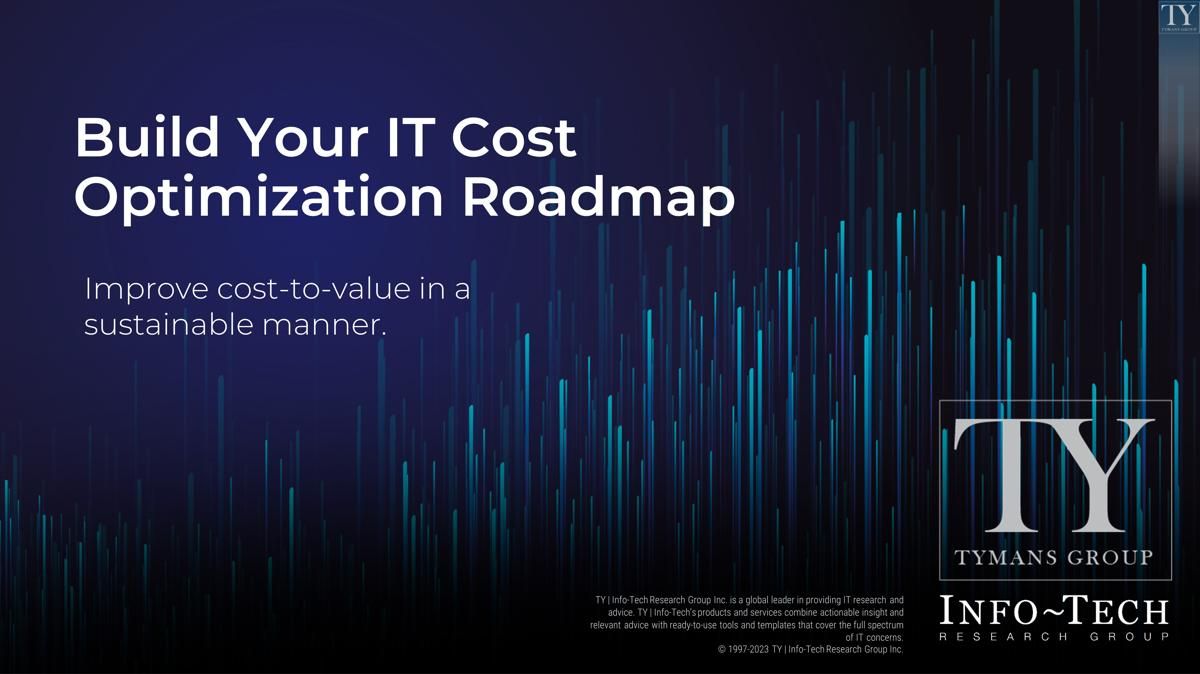
Cost optimization is misunderstood and inadequately tackled. IT departments face:
- Top-down budget cuts within a narrow time frame
- Absence of adequate governance: financial, project, data, etc.
- Long-standing bureaucratic practices slowing down progress
- Short-term thinking
Our Advice
Critical Insight
Cost optimization is not just about reducing costs. In fact, you should aim to achieve three objectives:
- Reduce your unwarranted IT spending.
- Optimize your cost-to-value.
- Sustain your cost optimization.
Impact and Result
- Follow Info-Tech’s approach to develop a 12-month cost optimization roadmap.
- Develop an IT cost optimization strategy based on your specific circumstances and timeline.
- Info-Tech’s methodology helps you maintain sustainable cost optimization across IT by focusing on four levers: assets, vendors, project portfolio, and workforce.
Build Your IT Cost Optimization Roadmap Research & Tools
Besides the small introduction, subscribers and consulting clients within this management domain have access to:
1. IT Cost Optimization Roadmap Deck – A step-by-step methodology to achieve sustainable cost optimization and effectively communicate your strategy to stakeholders.
This blueprint will help you understand your IT cost optimization mandate, identify your journey, assess your IT spend across four levers, develop your IT cost optimization roadmap, and craft a related communication strategy.
- Build Your IT Cost Optimization Roadmap – Phases 1-4
2. IT Cost Optimization Workbook – A structured tool to help you document your IT cost optimization goals and outline related initiatives to develop an effective 12-month roadmap.
This tool guides an IT department in planning and prioritization activities to build an effective IT cost optimization strategy. The outputs include visual charts and a 12-month roadmap to showcase the implementation timelines and potential cost savings.
- IT Cost Optimization Workbook
3. IT Cost Optimization Roadmap Samples and Templates – A proactive journey template to help you communicate your IT cost optimization strategy to stakeholders in a clear, concise, and compelling manner.
This presentation template uses sample data from "Acme Corp" to demonstrate an IT cost optimization strategy following a proactive journey. Use this template to document your final IT cost optimization strategy outputs, including the adopted journey, IT cost optimization goals, related key initiatives, potential cost savings, timelines, and 12-month roadmap.
- IT Cost Optimization Roadmap Samples and Templates
Infographic
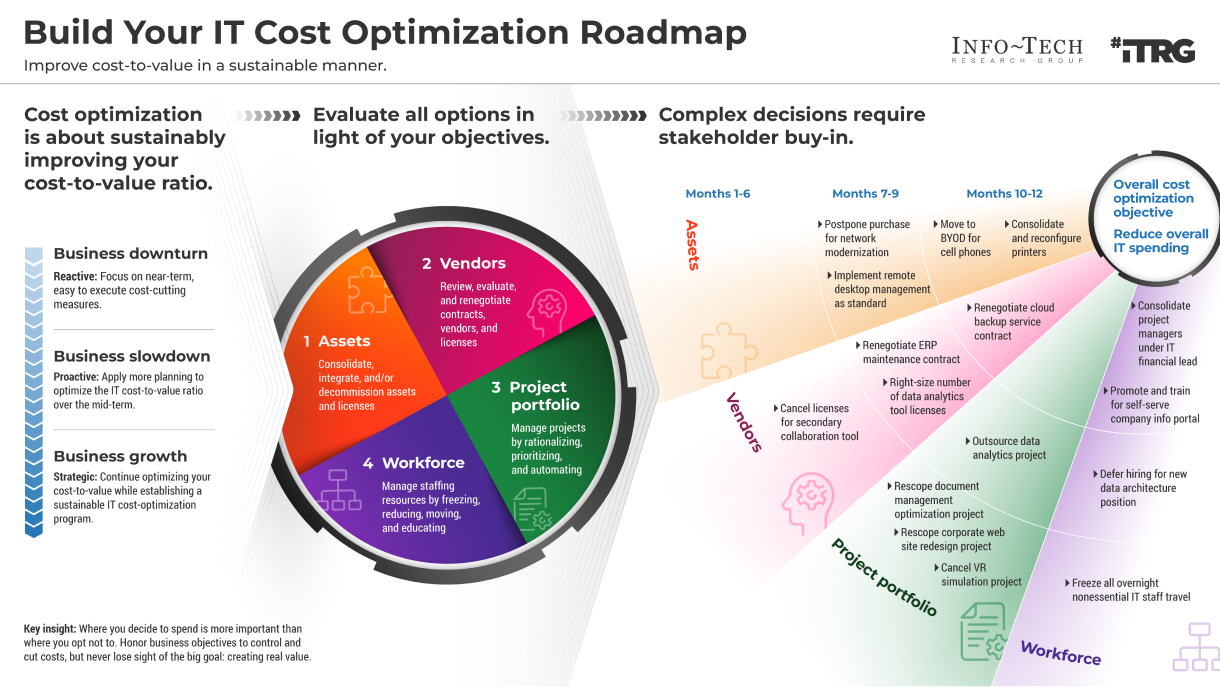
Workshop: Build Your IT Cost Optimization Roadmap
Workshops offer an easy way to accelerate your project. If you are unable to do the project yourself, and a Guided Implementation isn't enough, we offer low-cost delivery of our project workshops. We take you through every phase of your project and ensure that you have a roadmap in place to complete your project successfully.
1 Understand Your Mandate & Objectives
The Purpose
Determine your organization’s current context and its cost optimization objectives, IT’s corresponding cost optimization journey, and goals.
Key Benefits Achieved
A business-aligned set of specific IT cost optimization goals.
Activities
1.1 Understand your organization’s cost optimization objectives and how this impacts IT.
1.2 Review potential cost optimization target areas based on your ITFM Benchmarking Report.
1.3 Identify factors constraining cost optimization options.
1.4 Set concrete IT cost optimization goals.
1.5 Identify inputs required for decision making.
Outputs
IT cost optimization journey and guiding principles for making corresponding decisions
2 Outline Initiatives for Vendors & Assets
The Purpose
Create a longlist of potential cost optimization initiatives focused on two cost optimization levers: assets and vendors.
Key Benefits Achieved
A comprehensive list of potential asset- and vendor-focused initiatives including cost savings estimates.
Activities
2.1 Identify a longlist of possible initiatives around asset lifecycle management, investment deferral, repurposing, etc., and vendor contract renegotiation, cancelation, etc.
2.2 Estimate the cost savings of cost optimization initiatives.
Outputs
Longlist of potential vendor management and asset optimization IT cost optimization initiatives
3 Outline Initiatives for Projects & Workforce
The Purpose
Create a longlist of potential cost optimization initiatives focused on two cost optimization levers: project portfolio and workforce.
Key Benefits Achieved
A comprehensive list of potential initiatives focused on project portfolio and workforce including cost savings estimates.
Activities
3.1 Identify a longlist of possible initiatives around project priorities, project backlog reduction, project intake restructuring, etc., and workforce productivity, skills, redeployment, etc.
3.2 Estimate the cost savings of cost optimization initiatives.
Outputs
Longlist of possible cost optimization initiatives and their potential cost savings for project portfolio and workforce levers.
4 Build an IT Cost Optimization Roadmap
The Purpose
Develop a visual IT cost optimization roadmap.
Key Benefits Achieved
A prioritized, business-aligned IT cost optimization roadmap
Activities
4.1 Assess feasibility of each initiative (effort and risk profile) given cost optimization goals.
4.2 Prioritize cost optimization initiatives to create a final shortlist.
4.3 Fine-tune key information about your final cost optimization initiatives and develop a cost optimization roadmap for proposal.
Outputs
Prioritized list of key cost optimization initiatives, descriptions, estimated impact, and roadmap.
5 Communicate & Execute
The Purpose
Develop a communication plan and executive presentation.
Key Benefits Achieved
A boardroom-ready set of communication materials for gaining buy-in and support for your IT cost optimization roadmap.
Activities
5.1 Outline components of a communication plan, including approvers, stakeholders, and governance and management mechanisms to be used.
5.2 Create an executive presentation.
5.3 Set up review time for workshop deliverables and post-workshop activities.
Outputs
IT cost optimization communication plan and presentation strategy.
IT Cost Optimization Executive Presentation
Further reading
Build Your IT Cost Optimization Roadmap
Improve cost-to-value in a sustainable manner.
Analyst Perspective
Optimize your cost sustainably.
Whether the industry is in an economic downturn, or your business is facing headwinds in the market, pressure to reduce spending across organizations is inevitable. When it comes to the IT organization, it is often handled as a onetime event. Cost optimization is an industry standard term, but it usually translates into cost cutting. How do you manage this challenge given the day-to-day demands placed on IT? Do you apply cost reduction equally across the IT landscape, or do you apply reductions using a targeted approach? How do you balance the business demands regarding innovation with keeping the lights on? What is the best path forward?
While the situation isn't unique, all too often the IT organization response is too shortsighted.
By using the Info-Tech methodology and tools, you will be able to develop an IT cost optimization roadmap based on your specific circumstances and timeline.
A well-thought-out strategy should help you achieve three objectives:
- Reduce your unwarranted IT spending.
- Optimize your cost-to-value.
- Sustain your cost optimization.
This blueprint will guide you to understand your mandate, identify your cost optimization journey (reactive, proactive, or strategic), and assess your IT spend across four levers (assets, vendors, project portfolio, and workforce).
Finally, keep in mind that cost optimization is not a project to be completed, but an ongoing process to be exercised.

Bilal Alberto Saab
Research Director, IT Financial Management
Info-Tech Research Group
Executive Summary
| Cost optimization is misunderstood and inadequately tackled | Common obstacles | Follow Info-Tech's approach to develop a 12-month cost optimization roadmap |
|
|
Develop an IT cost optimization strategy based on your specific circumstances and timeline. Info-Tech's methodology helps you maintain sustainable cost optimization across IT by focusing on four levers:
|
Info-Tech Insight
Cost optimization is not just about reducing costs. In fact, you should aim to achieve three objectives: (1) reduce your unwarranted IT spending, (2) optimize your cost-to-value, and (3) sustain your cost optimization.
Your challenge
IT leaders are often asked to cut costs.
- Cost management is a long-term challenge. Businesses and IT departments look to have a flexible cost structure focused on maximizing business value while maintaining the ability to adapt to market pressure. However, businesses must also be able to respond to unexpected events.
- In times of economic downturn, many CEOs and CFOs shift their thinking from growth to value protection. This can force a round of cost cutting across all departments focused on short-term, immediate, and measurable objectives.
- Many IT departments are then faced with the challenge of meeting cost cutting targets. No one knows exactly how markets will behave, but the effects of rising inflation and increasing interest rates, for example, can manifest very quickly.
When crisis hits, does IT's hard-won gains around being seen as a partner to the business suddenly disappear and IT becomes just a cost center all over again?
In times of economic slowdown or downturn, the key challenge of IT leaders is to optimize costs without jeopardizing their strategic and innovative contribution.
Common obstacles
The 90% of the budget you keep is more important than the 10% of the budget you cut.
- While the business responds to fluctuating economic conditions, IT must ensure that its budget remains fully aligned with business strategy and expected business value.
- However, in the face of sudden pressures, a common tendency is to make quick decisions without fully considering their long-term implications.
- Avoid costly mistakes with a proactive and strategic mindset. Put in place a well-communicated cost optimization strategy rather than hastily cutting back the biggest line items in your budget.
How can IT optimize costs to achieve a corporate impact, but not cut so deep that the organization can't take advantage of opportunities to recover and thrive?
Know how you will strategically optimize IT costs before you are forced to cut cost aggressively in a reactive fashion.
What is cost optimization?
It's not just about cutting costs
- While cost optimization may involve cutting costs, it is more about making smart spend and investment decisions.
- At its core, cost optimization is a strategic decision-making process that sets out to minimize waste and get the most value for money.
- Cost optimization encompasses near-term, mid-term, and long-term objectives, all of which are related and build upon one another. It is an accumulative practice, not a onetime exercise.
- A sound cost optimization practice is inherently flexible, sustainable, and consequence-oriented with the positive goal of generating net benefit for the organization over time.
Change your mindset ...
An Info-Tech survey of IT staff reveals that while most agree that cost optimization is an important IT process, nearly 20% fewer of them agree that it's being managed well.

Info-Tech IT Management & Governance Diagnostic, 2022.
A starting point for cost optimization improvement is adjusting your frame of mind. Know that it's not just about making difficult cuts - in reality, it's a creative pursuit that's about thriving in all circumstances, not just surviving.
Slow revenue growth expectations generate urgency
Many IT organizations will be directed to trim costs during turbulent times.
- Cost optimization implies continuous cost management, which entails long-term strategic initiatives (i.e. organizations and their IT departments seek flexible cost structures and practices focused on maximizing business value while maintaining the ability to adapt to changes in the broader economic environment). However, organizations must also be able to respond to unexpected events.
- During times of turmoil – poor economic outlook expected to negatively impact an organization's bottom line – CEOs and CFOs think more about survival than growth, driving cost cutting across all departments to create short-term, immediate, and measurable financial benefits.
- In such situations, many IT departments will be hard-pressed to meet cost cutting targets at short notice. If not planned correctly, with a tunnel vision focus instead of a strategic one, you can end up hurting yourself in the not-so-distant future.
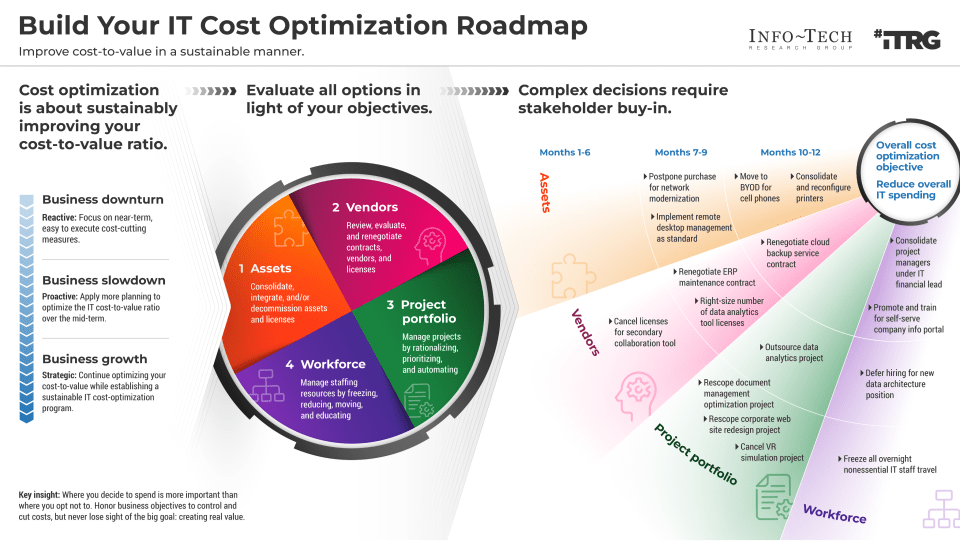
Insight summary
Sustain an optimal cost-to-value ratio across four levers:
- Assets
- Vendors
- Project Portfolio
- Workforce
Cost optimization is not just about reducing costs
In fact, you should aim to achieve three objectives:
(1) reduce your unwarranted IT spending, (2) optimize your cost-to-value, and (3) sustain your cost optimization.
Reduce unwarranted IT spending
Stop the bleeding or go for quick wins
Start by reducing waste and bad spending habits while clearly communicating your intentions to your stakeholders – get buy-in.
Optimize cost-to-value
Value means tradeoffs
Pursue value but know that it will lead you to make tradeoffs between cost, performance, and risk.
Sustain cost optimization
Think about tomorrow: reduce, reuse, recalibrate, and repeat
Standardize and automate your cost optimization processes around a proper governance framework. Cost optimization is not a onetime exercise.
Info-Tech's methodology for building your IT cost optimization roadmap
|
Phase 1: Understand Your Mandate & Objectives Know where you stand and where you're going. Understand your cost optimization mandate within the context of your organization's situation and direction. |
Phase 2: Outline Your Initiatives Evaluate many, pick a few. Think of all possible cost optimization initiatives across the four optimization levers (Assets, Vendors, Project Portfolio, and Workforce), but only keep the ones that best help you fulfill your goals. |
Phase 3: Develop Your Roadmap Keep one eye on today and the other on tomorrow. Prioritize cost optimization initiatives that would help you achieve your near-term objectives first, but don't forget about the medium and long term. |
Phase 4: Communicate and Execute Communicate and collaborate - you are not a one-person show. Reach out to other business units where necessary. Your success relies on getting buy-in from various stakeholders, especially when cost optimization initiatives impact them in one way or another. |
Blueprint deliverables
Each step of this blueprint is accompanied by supporting deliverables to help you accomplish your goals:
IT Cost Optimization Roadmap Samples and Templates
Templates including an abbreviated executive presentation and a final communication presentation based on a 12-month cost optimization roadmap.
IT Cost Optimization Workbook
A workbook generating a 12-month cost optimization roadmap.
Measure the value of this blueprint
Maintain an optimal IT cost-to-organization revenue ratio.
This blueprint will guide you to set cost optimization goals across one to three main objectives, depending on your identified journey (reactive, proactive, or strategic):
- Reduce unwarranted IT spending.
- Optimize cost-to value.
- Sustain cost optimization.
In phase 1 of this blueprint, we will help you establish your goals to satisfy your organization's needs.
In phase 3, we will help you develop a game plan and a roadmap for achieving those metrics.
Once you implement your 12-month roadmap, start tracking the metrics below over the next fiscal year (FY) to assess the effectiveness of undertaken measures.
| Cost Optimization Objective | Key Success Metric |
| Reduce unwarranted IT spending | Decrease IT cost in identified key areas |
| Optimize cost-to-value | Decrease IT cost per IT employee |
| Sustain cost optimization | Decrease IT cost-to-organization revenue |
Info-Tech offers various levels of support to best suit your needs
| DIY Toolkit "Our team has already made this critical project a priority, and we have the time and capability, but some guidance along the way would be helpful." |
Guided Implementation "Our team knows that we need to fix a process, but we need assistance to determine where to focus. Some check-ins along the way would help keep us on track." |
Workshop "We need to hit the ground running and get this project kicked off immediately. Our team has the ability to take this over once we get a framework and strategy in place. |
Consulting "Our team does not have the time or the knowledge to take this project on. We need assistance through the entirety of this project." |
Diagnostics and consistent frameworks are used throughout all four options.
Guided implementation
What does a typical GI on this topic look like?
| Phase 1 | Phase 2 | Phase 3 | Phase 4 | |
|---|---|---|---|---|
Call #1:
|
Call #2:
Review potential cost optimization initiatives for assets and vendors levers. Call #3: Assess cost optimization initiatives' cost and feasibility - for assets and vendors levers. |
Call #4:
Review potential cost optimization initiatives for project portfolio and workforce levers. Call #5: Assess cost optimization initiatives' cost and feasibility - for project portfolio and workforce levers. |
Call #6:
|
Call #7:
|
A Guided Implementation (GI) is a series of calls with an Info-Tech analyst to help implement our best practices in your organization.
A typical GI will include multiple calls over the course of one to two months.
IT cost analysis and optimization workshop overview
| Session 1 | Session 2 | Session 3 | Session 4 | Session 5 | |
|---|---|---|---|---|---|
| Activities | Understand Your Mandate and Objectives | Outline Initiatives for Assets and Vendors | Outline Initiatives for Projects and Workforce | Develop an IT Cost Optimization Roadmap | Communicate and Execute |
| 1.1 Understand your organization's cost optimization objectives and how this impacts IT. 1.2 Review potential cost optimization target areas based on your IT financial management benchmarking report. 1.3 Identify factors constraining cost optimization options. 1.4 Set concrete IT cost optimization goals. 1.5 Identify inputs required for decision making. |
2.1 Identify a longlist of possible initiatives around:
|
3.1 Identify a longlist of possible initiatives around:
|
4.1 Assess the feasibility of each initiative (effort and risk profile) given cost optimization goals. 4.2 Prioritize cost optimization initiatives to create a final shortlist. 4.3 Fine-tune key information about your final cost optimization initiatives and develop a cost optimization roadmap for proposal. |
5.1 Outline components of a communication plan, including approvers, stakeholders, and governance and management mechanisms to be used. 5.2 Create an executive presentation. 5.3 Set up review time for workshop deliverables and post-workshop activities. |
|
| Output |
|
|
|
|
|
Contact your account representative for more information.
workshops@infotech.com 1-888-670-8889
Phase 1
Understand Your Mandate and Objectives
Phase 1
Understand Your Mandate and Objectives
Phase 2
Outline Your Cost Optimization Initiatives
Phase 3
Develop Your IT Cost Optimization Roadmap
Phase 4
Communicate and Execute
This phase will walk you through the following activities:
- Business context and cost optimization journey
- Cost constraints and parameters
- Cost optimization goals
This phase involves the following participants:
- CIO/IT director
- IT finance lead
1.1 Gain consensus on the business context and IT cost optimization journey
60 minutes
- Using the questions on slide 20, conduct a brief journey assessment to ensure consensus on the direction you are planning to take.
- Document your findings in the provided template.
| Input | Output |
|---|---|
|
|
| Materials | Participants |
|
|
See the next three slides for guidelines and the journey assessment questions and template.
Distinguishing between three journeys
By considering business objectives without forgoing your IT mandate.
| Journey | Reactive | Proactive | Strategic |
|---|---|---|---|
| Description |
|
|
|
| Main Focus |
|
|
|
Questions to help determine your journey
| Business Objectives | Business Strategy |
|---|---|
|
|
| IT Objectives | IT Strategy and Mandate |
|
|
| Journey | |
| Agreed-upon journey: reactive, proactive, or strategic. | |
Template & Example
Journey assessment
| Business Objectives | Business Strategy |
|---|---|
|
|
| IT Objectives | IT Strategy and Mandate |
|
|
| Journey | |
| Agreed-upon journey: proactive. | |
1.2 Review internal and external benchmarking reports
60-90 minutes
- Review the IT spend and staffing results, summarized in your Info-Tech IT Spend & Staffing Benchmarking report.
- Identify areas where your IT spend is disproportionately high or low in comparison with your industry peers.
- Review and document any causes or rationales for high or low spend in each area identified. Do not be specific about any actual optimization targets or actions at this stage - simply make notes.
- Start a list of potential cost optimization initiatives to be further analyzed and investigated for feasibility at a later stage (see next slides for guidance, example, and template).
| Input | Output |
|---|---|
|
|
| Materials | Participants |
|
|
Info-Tech's approach
Our IT cost model maps your IT spending and staffing according to four key views, putting IT spend in language that stakeholders across the organization can relate to.
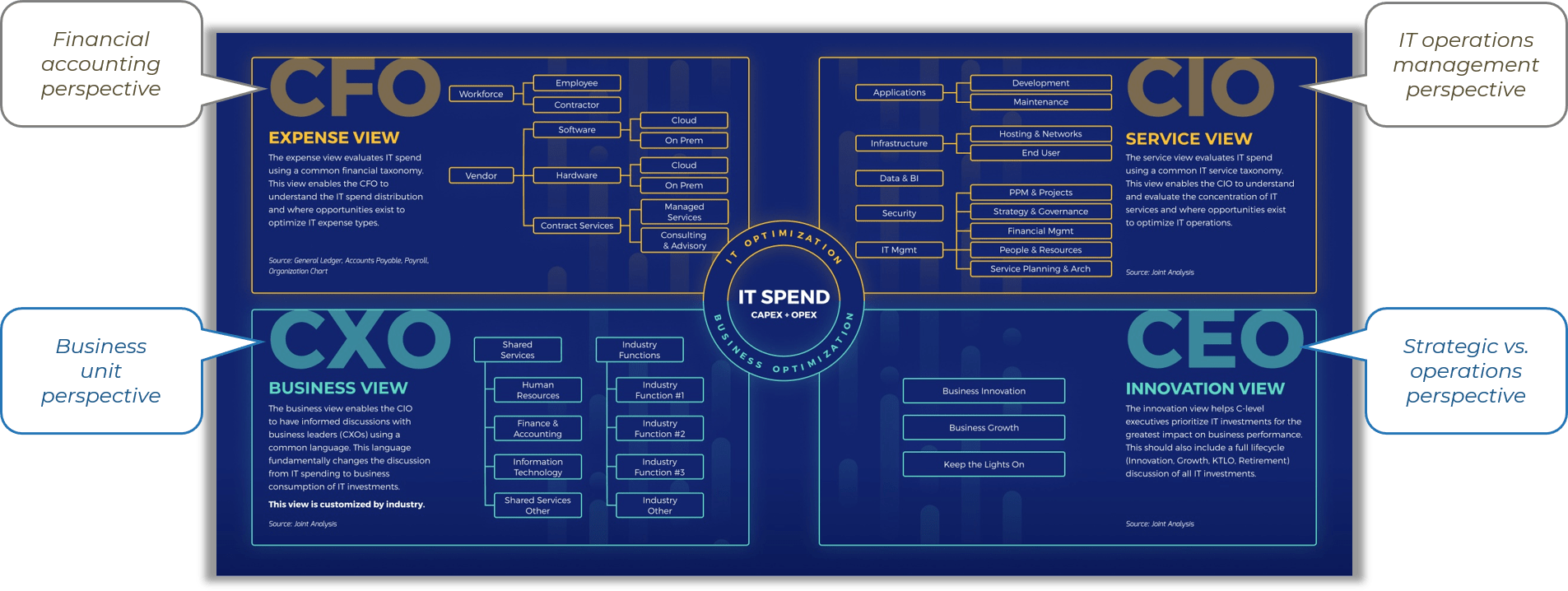
Template & Example
Potential cost optimization initiatives list
Brainstorm and list potential cost optimization initiatives at a macro level.
| Potential Initiative | Source | Source Contact | Notes |
|---|---|---|---|
| Reduce application maintenance cost | Internal Benchmarking Report | CIO | Based on current year report |
| Rationalize software applications | Info-Tech IT Benchmarking Report | CIO | Based on current year report |
| Migrate key business applications to the cloud | Latest iteration of the IT strategy | CIO | New IT strategy will be in development concurrent with cost optimization strategy development |
| Align job roles to the current IT structure | IT org. chart and salaries | HR, CIO | Based on information of the current year and will likely change in a few months (beginning of a new year) |
| Renegotiate the top five vendor contracts up for renewal this year | List of IT vendors | Procurement office, CIO, IT infrastructure director, IT applications director, IT services manager | Based on a list consolidated last week |
Want help with your IT spend transparency and benchmarking efforts?
Let us fast-track your IT spend journey.
The path to IT financial management maturity starts with knowing exactly where your money is going. To streamline this effort, Info-Tech offers an IT Spend & Staffing Benchmarking service that provides full transparency into where your money is going without any heavy lifting on your part.
This unique service features:
- A client-proven approach to meet your IT spend transparency goals.
- Spend and staff mapping that reveals business consumption of IT.
- Industry benchmarking to compare your spending and staffing to that of your peers.
- Results in a fraction of the time with much less effort than going it alone.
- Expert review of results and ongoing discussions with Info-Tech analysts.
If you'd like Info-Tech to pave the way to IT spend transparency, contact your account manager for more information - we're happy to talk anytime.
1.3 Identify your overarching constraints
30 minutes
- Assess where spend change opportunities are currently limited or nonexistent due to organization edict or policy, industry regulatory requirements, or active contracts. Ask yourself:
- Where do IT spend bottlenecks exist and what are they?
- What IT spend objectives and practices are absolutely mandatory and nonnegotiable from both a business and an IT perspective?
- Are there areas where spend change is possible but would be very difficult to execute due to the stakeholders involved, governance processes, time frames, or another constraining factor?
- Identify where reduction or elimination of an IT service would negatively affect required service levels and business continuity or recovery.
- List constraints as negotiable or nonnegotiable on the template provided.
- Remove areas of focus from your cost optimization scope that land outside achievable parameters, and flag those that are difficult but still possible.
| Input | Output |
|---|---|
|
|
| Materials | Participants |
|
|
See the next slides for additional guidance and a constraints assessment template.
Acknowledge your limitations
By recognizing your constraints, which will lead you to define your cost optimization scope.
| Constraints | Organizational | Legal/Regulatory | Other |
|---|---|---|---|
| What | An organizational constraint is any work condition that hinders an employee's performance - be it physical, emotional, or otherwise. | A legal or regulatory constraint is any law, rule, standard, or regulation - be it industry specific or otherwise - limiting the ability of any stakeholder to get the most out of a certain activity, initiative, or project. | Other types of constraints affecting business units. |
| Who | Collaborate with your IT leaders and business partners to identify all major constraints that would affect cost optimization initiatives. | ||
| How | Discussions and information sessions to distinguish between negotiable and nonnegotiable constraints that would thwart cost optimization efforts:
|
||
| Challenge | Degree to which you can influence certain outcomes within a set time frame:
|
||
We define a constraint as a restriction controlling the behavior of any of your stakeholders, hence preventing a desired outcome.
In our context, constraints will determine your playing field: the boundaries of your cost optimization scope.
Distinguish between constraints
Negotiable vs. nonnegotiable to delimit your cost optimization scope.
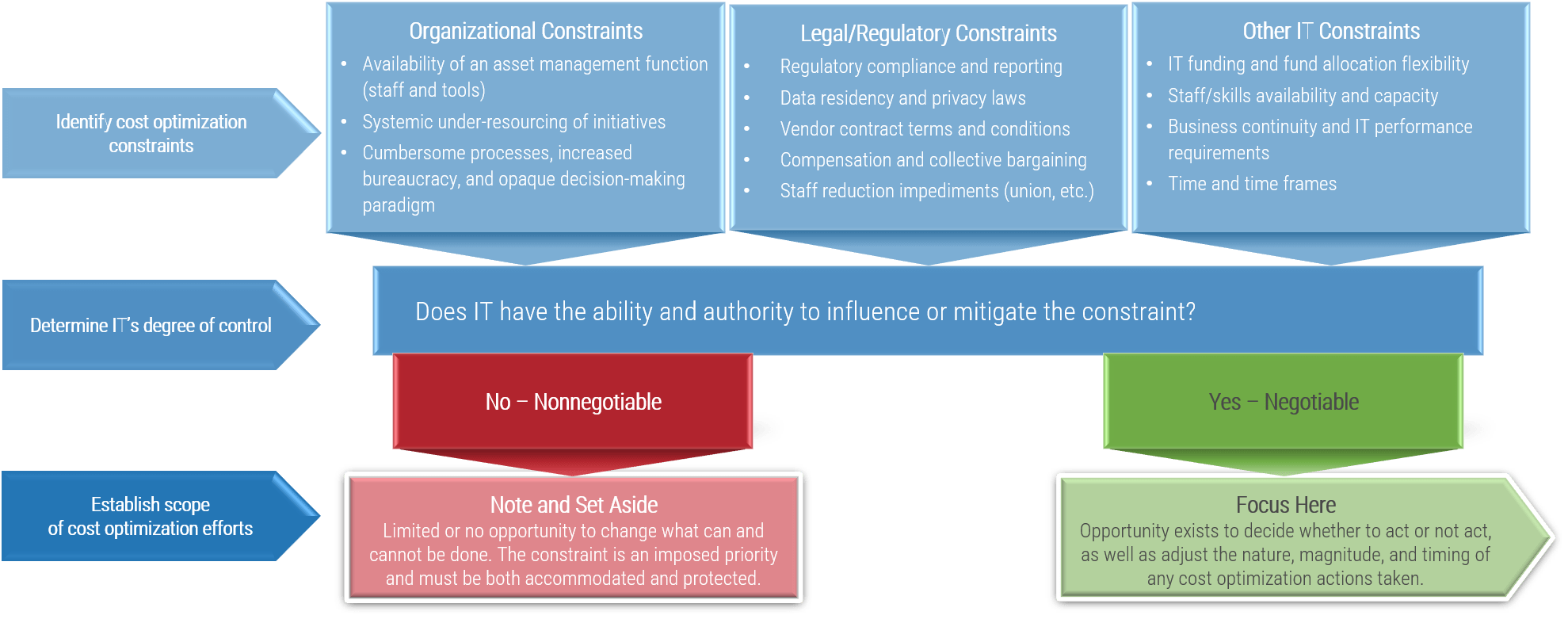
Template & Example
Constraints assessment
List high-level limitations that hinder your cost optimization options.
| Nonnegotiable constraints | ||
|---|---|---|
| Organizational | Legal/Regulatory | IT/Other |
| Prioritization of sales/customer service activities | SEC compliance/reporting mandates | Production unit incident response service levels |
| [Constraint] | [Constraint] | [Constraint] |
| [Constraint] | [Constraint] | [Constraint] |
| [Constraint] | [Constraint] | [Constraint] |
| Negotiable constraints | ||
| Organizational | Legal/Regulatory | IT/Other |
| Core business operations process design | Vendor contracts up for near-term renewal | Current capital project commitments |
| [Constraint] | [Constraint] | [Constraint] |
| [Constraint] | [Constraint] | [Constraint] |
| [Constraint] | [Constraint] | [Constraint] |
1.4 Establish overarching cost optimization goals
60-90 minutes
- Establish specific IT cost optimization goals. Depending on your journey, step 1.1. You will have one to three overarching cost optimization goals, as follows:
- Reactive: Cost-cutting goal to reduce unwarranted IT spending.
- Proactive: Cost-to-value optimization goal.
- Strategic: Cost optimization sustainability goal.
- Document your final cost optimization goals in the IT Cost Optimization Workbook.
- Revisit your goals after outlining your initiatives (phase 2) to ensure feasibility depending on your journey.
Download the IT Cost Optimization Workbook
| Input | Output |
|---|---|
|
|
| Materials | Participants |
|
|
Template & Example
Document your overarching goals
Excel Workbook: IT Cost Optimization – Set Optimization Goals Worksheet
Refer to the example and guidelines below on how to document your goals based on your journey:
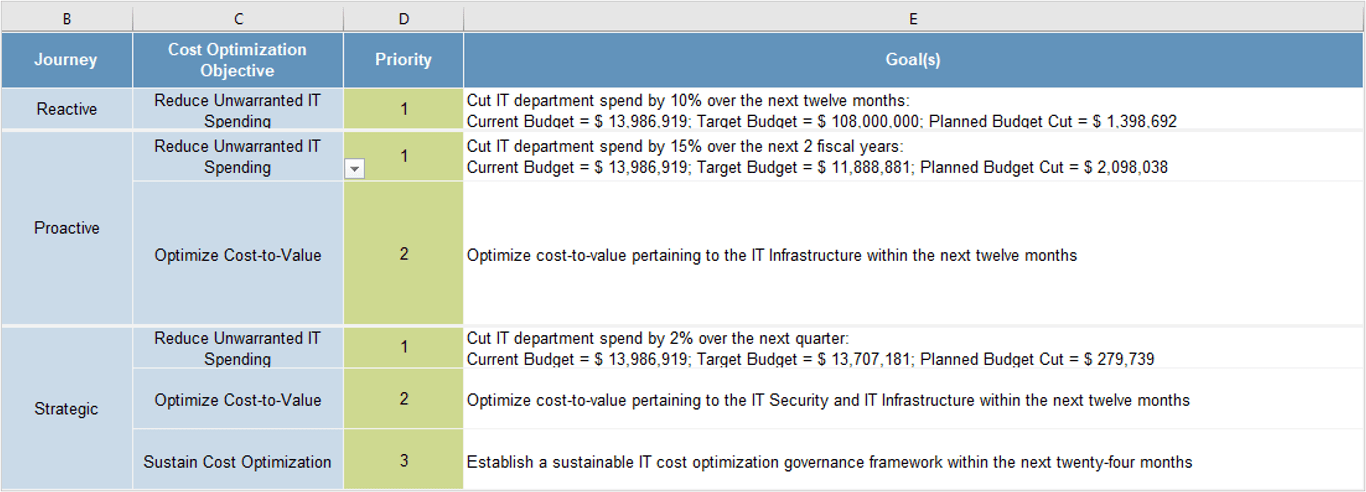
| Column ID | Input Type | Guidelines |
|---|---|---|
| B | Dropdown | Select the appropriate journey: Reactive, Proactive, or Strategic. |
| C | Dropdown | Select the appropriate cost optimization objective: Reduce Unwarranted IT Spending, Optimize Cost-to-Value, Sustain Cost Optimization. |
| D | Formula | Automatic calculation, no entry required. Reduce Unwarranted IT Spending goal is the first priority, followed by Optimize Cost-to-Value, and Sustain Cost Optimization goals, respectively. |
| E | Text | Enter the overarching goal related to each objective. |
Complete the following fields for each goal depending on your journey in the Excel Workbook as per guidelines:
- Navigate to the Set Cost Optimization Goals tab.
- Identify your journey and objective for each goal.
- Document your goal(s).
Download the IT Cost Optimization Workbook
Template & Example
Break down your goals per quarter
Excel Workbook: IT Cost Optimization - Set Cost Optimization Goals Worksheet
Refer to the example and guidelines below on how to break down your goals per quarter and track your progress:
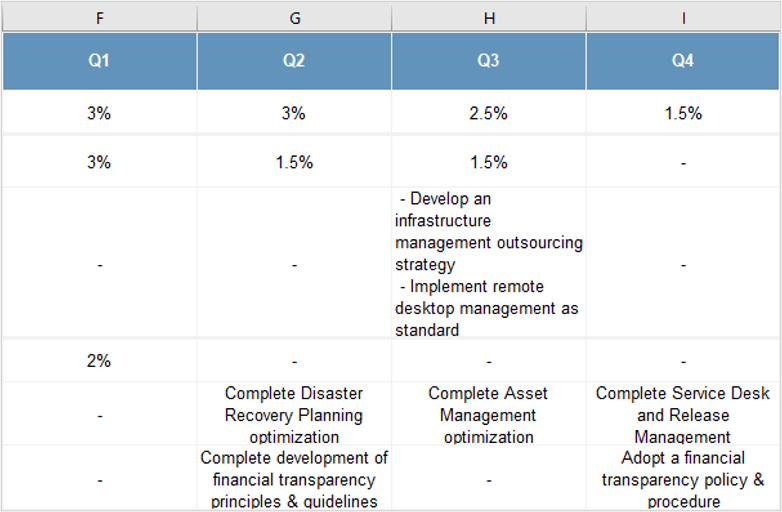
| Column ID | Input Type | Guidelines |
|---|---|---|
| F, G, H, I | Text | Enter the target per quarter: It could be a percentage, dollar amount, or description of the breakdown, depending on the cost optimization goal and objective. |
Complete the following fields for each goal depending on your journey in the Excel Workbook as per guidelines:
- Navigate to the Set Cost Optimization Goals tab.
- Determine your target per quarter for every goal.
- Document your targets.
Download the IT Cost Optimization Workbook
1.5 Identify inputs required for decision making
60-90 minutes
- Each of the optimization levers (assets, vendors, project portfolio, and workforce) will require specific and unique sources of information which you will need to collect before moving forward.
Examples of important sources of information include:
- Latest iteration of the IT strategy.
- List of IT assets (hardware, software).
- List of IT services or IT service catalog.
- List of current and planned IT projects and their resourcing allocations.
- List of largest vendor contracts and their key details, such as their expiration/renewal date.
- IT department organizational chart and salaries (by role).
- Review and analyze each of the documents.
- Continue to list potential cost optimization initiatives (step 1.2) to be further analyzed and investigated for feasibility at a later stage.
| Input | Output |
|---|---|
|
|
| Materials | Participants |
|
|
Prepare all pertinent sources of information
And start drafting your cost optimization laundry list.
| Documents | Benchmarking | IT Strategy | Other Information Sources |
|---|---|---|---|
| What |
|
|
|
| Who | Collaborate with your IT leaders and business partners to:
|
||
| How | Discussions and information sessions to analyze and deep dive on raw findings. | ||
| Challenge | Time to compile and analyze reports without affecting day-to-day operations:
|
||
Phase 2
Outline Your Cost Optimization Initiatives
Phase 1
Understand Your Mandate and Objectives
Phase 2
Outline Your Cost Optimization Initiatives
Phase 3
Develop Your IT Cost Optimization Roadmap
Phase 4
Communicate and Execute
This phase will walk you through the following activities:
- IT cost optimization initiatives
- IT cost optimization workbook
This phase involves the following participants:
- CIO/IT director
- IT finance lead
- IT asset manager
- IT infrastructure manager
- IT vendor management lead
- PMO lead
- IT talent management representative
- Other IT management
Outline your cost optimization initiatives
Across Info-Tech's four levers.
| Levers | ASSETS | VENDORS | PROJECT PORTFOLI | WORKFORCE |
|---|---|---|---|---|
| What |
|
|
|
|
| Who | Collaborate with your IT leaders and business partners to:
|
|||
| How | You will decide on the best course of action depending on your journey. | |||
Most common cost optimization challenges
Across Info-Tech's four levers.
| Levers | ASSETS | VENDORS | PROJECT PORTFOLI | WORKFORCE |
|---|---|---|---|---|
| Challenge |
|
|
|
|
| Solution |
|
|
|
|
| Related Info-Tech Research | Develop an IT Asset Management Strategy | Jump-start Your Vendor Management Initiative | Develop a Project Portfolio Management Strategy | Build a Strategic IT Workforce Plan |
2.1 Determine your cost optimization initiatives
8 hours
Now that you have identified your journey and understood your constraints:
- Review your list of potential cost optimization initiatives and document viable ones in the IT Cost Optimization Workbook.
- Think of potential cost optimization initiatives within the four levers: assets, vendors, project portfolio, and workforce. The following slides will help you in this endeavor.
Download the IT Cost Optimization Workbook
| Input | Output |
|---|---|
|
|
| Materials | Participants |
|
|
Plan your cost optimization initiatives
Your initiatives will differ depending on your journey
In terms of aggressiveness and objectives.
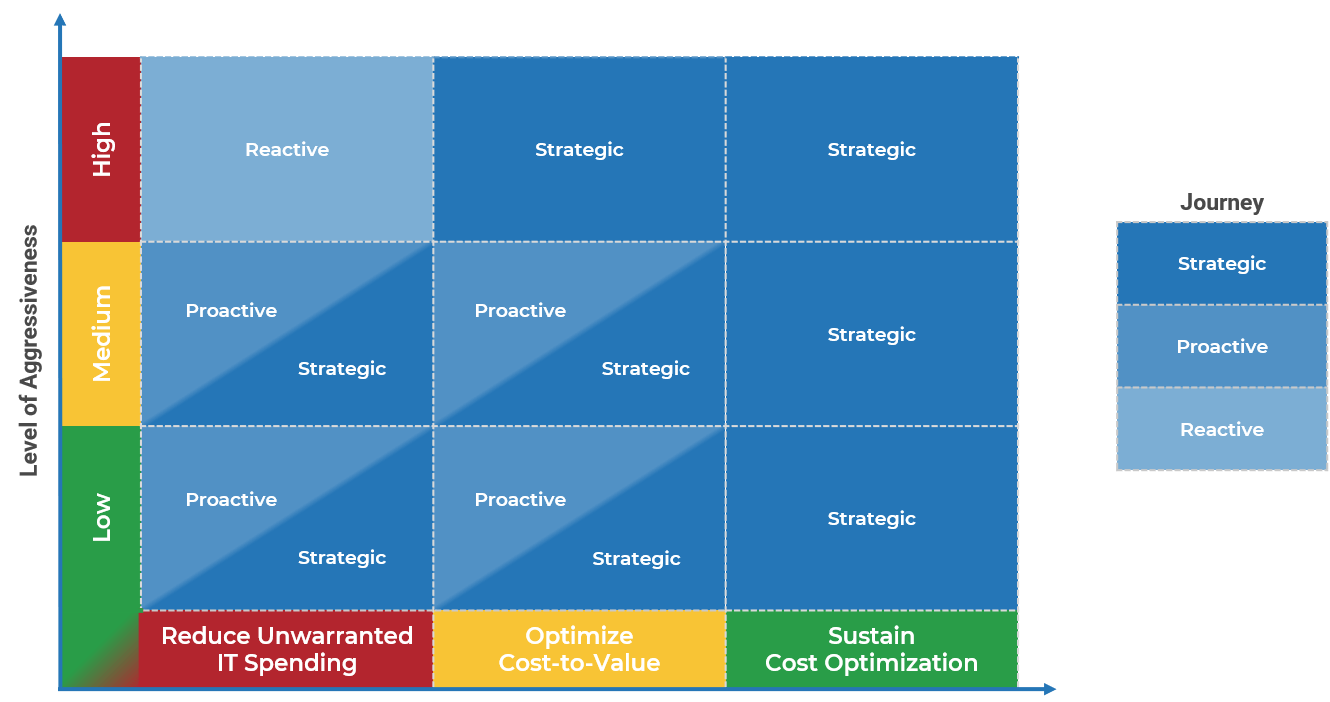
Cost optimization initiatives pertaining to a reactive journey are characterized by aggressive cost reduction.
On the other hand, cost optimization initiatives within a strategic journey can vary in aggressiveness across objectives.
2.1.1 Identify asset optimization initiatives
2 hours
- Review the IT asset management strategy if available. Compile a list of all hardware, software, and facility asset costs for delivery of IT services.
- Analyze hardware and software assets for opportunities to consolidate, reduce, eliminate, and/or enhance functionality/automation. Look for:
- Redundancy or duplication of functionality not necessary for disaster recovery or business continuity purposes.
- Low or no-use software.
- Homegrown or legacy systems with high maintenance/support burdens.
- Multiple, old, or unsupported versions of current-use software.
- Opportunities to delay hardware/software refreshes or upgrades.
- Cloud/outsourced options.
- Instances of unsanctioned shadow IT.
- Reassess your in-house asset management processes to see where efficiency and effectiveness could be improved overall.
- Document cost optimization initiatives that could be driven by asset optimization objectives in the IT Cost Optimization Workbook.
Download the IT Cost Optimization Workbook
| Input | Output |
|---|---|
|
|
| Materials | Participants |
|
|
Example
Asset optimization
Some examples to get you started
| Journey | Reactive, Proactive, or Strategic | Proactive or Strategic | Strategic |
|---|---|---|---|
| Initiatives |
|
|
|
| No initiatives for the reactive journey. | No initiatives for the reactive or proactive journeys. | ||
| Objective | Reduce Unwarranted IT Spending | Optimize Cost-to-Value | Sustain Cost Optimization |
Template & Example
List your objectives and initiatives
Excel Workbook: IT Cost Optimization – Outline Initiatives Worksheet
Refer to the example and guidelines below on how to input your asset optimization initiatives and related objectives:

| Column ID | Input Type | Guidelines |
|---|---|---|
| B | Formula | Automatic calculation, no entry required. The ID will update once there's an input in column E. |
| C | Dropdown | Select an optimization lever: Assets, Vendors, Project Portfolio, or Workforce. |
| D | Dropdown | Select an initiative focus from the dropdown list - this will help you think of initiatives. |
| E | Text | Enter your initiative. |
| F | Text | Write a brief description per initiative, providing a cost optimization rationale. |
| G | Dropdown | Select the cost type per initiative: OpEx (operating expenditure) or CapEx (capital expenditure). |
| H | Dropdown | Select 1 of 3 objectives for each initiative: Reduce Unwarranted IT Spending, Optimize Cost-to-Value, or Sustain Cost Optimization. |
List your initiatives in the provided Excel Workbook as per guidelines:
- Navigate to the Outline Initiatives tab.
- Enter all your initiatives driven by the asset optimization lever.
- Determine the cost optimization objective per initiative.
2.1.2 Identify vendor optimization initiatives
2 hours
- Revisit the IT vendor classification if available. Identify all existing vendor contracts up for renewal within the current fiscal year and create an inventory.
- Examine your vendor contracts to optimize your expected value from every IT provider you deal with. For each contract:
- Identify the business purpose/drivers.
- Identify the expiration/renewal date to determine time frames for action.
- Determine if there is an opportunity to rightsize, cancel, renegotiate costs/service levels, or postpone renewal/purchase.
- Identify integrations and interdependencies with other hardware and software systems to understand scope and impact of potential changes.
- Reassess your in-house vendor management processes to see where efficiency and effectiveness could be improved overall.
- Document cost optimization initiatives that could be driven by vendor optimization objectives in the IT Cost Optimization Workbook.
Download the IT Cost Optimization Workbook
| Input | Output |
|---|---|
|
|
| Materials | Participants |
|
|
Example
Vendor optimization
Some examples to get you started.
| Journey | Reactive, Proactive, or Strategic | Proactive or Strategic | Strategic |
|---|---|---|---|
| Initiatives |
|
|
|
| No initiatives for the reactive journey. | No initiatives for the reactive or proactive journeys. | ||
| Objective | Reduce Unwarranted IT Spending | Optimize Cost-to-Value | Sustain Cost Optimization |
Template & Example
List your objectives and initiatives
Excel Workbook: IT Cost Optimization – Outline Initiatives Worksheet
Refer to the example and guidelines below on how to input your vendor optimization initiatives and related objectives:

| Column ID | Input Type | Guidelines |
|---|---|---|
| B | Formula | Automatic calculation, no entry required. The ID will update once there's an input in column E. |
| C | Dropdown | Select an optimization lever: Assets, Vendors, Project Portfolio, or Workforce. |
| D | Dropdown | Select an initiative focus from the dropdown list - this will help you think of initiatives. |
| E | Text | Enter your initiative. |
| F | Text | Write a brief description per initiative, providing a cost optimization rationale. |
| G | Dropdown | Select the cost type per initiative: OpEx (operating expenditure) or CapEx (capital expenditure). |
| H | Dropdown | Select 1 of 3 objectives for each initiative: Reduce Unwarranted IT Spending, Optimize Cost-to-Value, or Sustain Cost Optimization. |
List your initiatives in the provided Excel Workbook as per guidelines:
- Navigate to the Outline Initiatives tab.
- Enter all your initiatives driven by the vendor optimization lever.
- Determine the cost optimization objective per initiative.
2.1.3 Identify project portfolio optimization initiatives
2 hours
- Review the IT Project Portfolio Strategy if available, and the list of both in-flight and planned projects.
- Reassess your project portfolio to maximize total value in line with business objectives and strategy. For each current and pending project on the list, identify a cost optimization initiative, including:
- Revisiting, confirming, and documenting actual project rationale with the business in relation to strategic goals.
- Rescoping existing projects that are underway.
- Accelerating planned or existing projects that enable business cost savings or competitive advantage and revenue growth.
- Canceling or postponing projects that are underway or haven't started.
- Identifying net-new projects that enhance business capabilities or save business costs.
- Reassess your in-house project management and project portfolio management processes to see where efficiency and effectiveness could be improved overall.
- Document cost optimization initiatives that could be driven by project portfolio optimization objectives in the IT Cost Optimization Workbook.
Download the IT Cost Optimization Workbook
| Input | Output |
|---|---|
|
|
| Materials | Participants |
|
|
Example
Project portfolio optimization
Some examples to get you started.
| Journey | Reactive, Proactive, or Strategic | Proactive or Strategic | Strategic |
|---|---|---|---|
| Initiatives |
|
|
|
| No initiatives for the reactive journey. | No initiatives for the reactive or proactive journeys. | ||
| Objective | Reduce Unwarranted IT Spending | Optimize Cost-to-Value | Sustain Cost Optimization |
Template & Example
List your objectives and initiatives
Excel Workbook: IT Cost Optimization – Outline Initiatives Worksheet
Refer to the example and guidelines below on how to input your project portfolio optimization initiatives and related objectives:

| Column ID | Input Type | Guidelines |
|---|---|---|
| B | Formula | Automatic calculation, no entry required. The ID will update once there's an input in column E. |
| C | Dropdown | Select an optimization lever: Assets, Vendors, Project Portfolio, or Workforce. |
| D | Dropdown | Select an initiative focus from the dropdown list - this will help you think of initiatives. |
| E | Text | Enter your initiative. |
| F | Text | Write a brief description per initiative, providing a cost optimization rationale. |
| G | Dropdown | Select the cost type per initiative: OpEx (operating expenditure) or CapEx (capital expenditure). |
| H | Dropdown | Select 1 of 3 objectives for each initiative: Reduce Unwarranted IT Spending, Optimize Cost-to-Value, or Sustain Cost Optimization. |
List your initiatives in the provided Excel Workbook as per guidelines:
- Navigate to the Outline Initiatives tab.
- Enter all your initiatives driven by the project portfolio optimization lever.
- Determine the cost optimization objective per initiative.
2.1.4 Identify workforce optimization initiatives
2 hours
- Review the IT department's strategic workforce plan (SWP) if available, organizational chart, and salaries by role. Do not review IT staffing in terms of named individuals who occupy a given role - focus on functions, roles, and job descriptions.
- Determine capability gaps:
- Rectify efficiency, effectiveness, and other performance issues.
- Train IT staff to enhance or improve skills and effectiveness.
- Add roles, skills, or headcount to improve effectiveness.
- Integrate teams to improve collaboration and reduce redundancies or break out new ones to increase focus/specialization.
- Redesign job roles and responsibilities.
- Redeploy/reassign staff to other teams.
- Conduct layoff (as a last resort, starting by assessing contractual employees).
- Document cost optimization initiatives that could be driven by workforce optimization objectives in the IT Cost Optimization Workbook.
Download the IT Cost Optimization Workbook
| Input | Output |
|---|---|
|
|
| Materials | Participants |
|
|
Example
Workforce optimization
Some examples to get you started.
| Journey | Reactive, Proactive, or Strategic | Proactive or Strategic | Strategic |
|---|---|---|---|
| Initiatives |
|
|
|
| No initiatives for the reactive journey. | No initiatives for the reactive or proactive journeys. | ||
| Objective | Reduce Unwarranted IT Spending | Optimize Cost-to-Value | Sustain Cost Optimization |
Template & Example
List your objectives and initiatives
Excel Workbook: IT Cost Optimization – Outline Initiatives Worksheet
Refer to the example and guidelines below on how to input your workforce optimization initiatives and related objectives:

| Column ID | Input Type | Guidelines |
|---|---|---|
| B | Formula | Automatic calculation, no entry required. The ID will update once there's an input in column E. |
| C | Dropdown | Select an optimization lever: Assets, Vendors, Project Portfolio, or Workforce. |
| D | Dropdown | Select an initiative focus from the dropdown list - this will help you think of initiatives. |
| E | Text | Enter your initiative. |
| F | Text | Write a brief description per initiative, providing a cost optimization rationale. |
| G | Dropdown | Select the cost type per initiative: OpEx (operating expenditure) or CapEx (capital expenditure). |
| H | Dropdown | Select 1 of 3 objectives for each initiative: Reduce Unwarranted IT Spending, Optimize Cost-to-Value, or Sustain Cost Optimization. |
List your initiatives in the provided Excel Workbook as per guidelines:
- Navigate to the Outline Initiatives tab.
- Enter all your initiatives driven by the workforce optimization lever.
- Determine the cost optimization objective per initiative.
2.2 Estimate the cost savings of cost optimization initiatives
8 hours
Now that you have identified your initiatives:
- Review your cost optimization initiatives per lever (Assets, Vendors, Project Portfolio, and Workforce).
- Determine whether the implementation cost of each of your initiatives is included as part of your budget.
- Estimate your cost savings.
- Document your assessment in the IT Cost Optimization Workbook.
Download the IT Cost Optimization Workbook
| Input | Output |
|---|---|
|
|
| Materials | Participants |
|
|
2.2.1 Estimate the costs impacting your asset optimization initiatives
2 hours
- Review each asset optimization initiative to estimate cost implications.
- Consider implementation cost in terms of your budget, and document it in the IT Cost Optimization Workbook (see next slides). Is the implementation cost of the underlying initiative considered in your current budget? If not, move to the next initiative. You will assess the flagged initiative independently at a later stage if deemed necessary.
- Estimate the current cost related to the initiative (including implementation cost), and document it in the IT Cost Optimization Workbook (see next slides). This will be the first of two inputs needed to calculate the initiative's potential cost savings.
- Estimate the expected cost, post initiative execution, of the underlying initiative, and document it in the IT Cost Optimization Workbook (see next slides). This will be the second and last input needed to calculate the initiative's potential cost savings.
Download the IT Cost Optimization Workbook
| Input | Output |
|---|---|
|
|
| Materials | Participants |
|
|
Template & Example
Estimate your cost
Excel Workbook: IT Cost Optimization – Outline Initiatives Worksheet
Refer to the example and guidelines below on how to complete cost estimates for each asset optimization initiative:
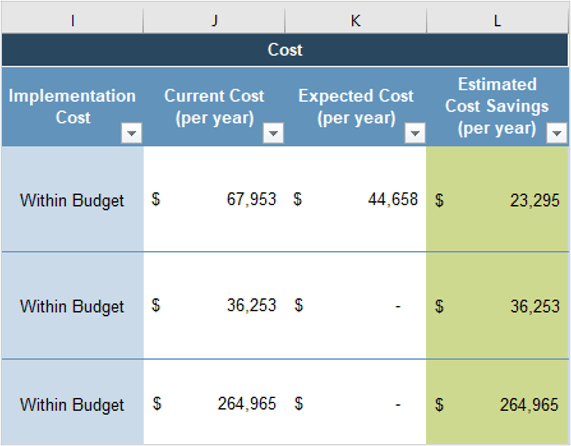
| Column ID | Input Type | Guidelines |
|---|---|---|
| I | Dropdown | Select if the implementation cost is considered within your budget or not. If not, the initiative will be flagged to be reviewed, and no further entry is required; move to the next initiative. Implementation cost represents your cost for planning, executing, and monitoring the related initiative. |
| J, K | Whole Number | Input a dollar amount. Current cost represents the yearly cost including implementing the initiative, while the expected cost represents the yearly cost after implementing the initiative. |
| L | Formula | Automatic calculation, no entry required. The difference between current cost and expected cost. |
Complete the following fields for each initiative in the Excel Workbook as per guidelines:
- Navigate to the Outline Initiatives tab.
- Determine if the implementation cost is considered within the budget.
- If yes, estimate the current cost, and expected cost of the underlying initiative.
2.2.2 Estimate the costs impacting your vendor optimization initiatives
2 hours
- Review each vendor optimization initiative to estimate cost implications.
- Consider implementation cost in terms of your budget, and document it in the IT Cost Optimization Workbook (see next slides). Is the implementation cost of the underlying initiative considered in your current budget? If not, move to the next initiative. You will assess the flagged initiative independently at a later stage if deemed necessary.
- Estimate the current cost related to the initiative (including implementation cost), and document it in the IT Cost Optimization Workbook (see next slides). This will be the first of two inputs needed to calculate the initiative's potential cost savings.
- Estimate the expected cost, post initiative execution, of the underlying initiative, and document it in the IT Cost Optimization Workbook (see next slides). This will be the second and last input needed to calculate the initiative's potential cost savings.
Download the IT Cost Optimization Workbook
| Input | Output |
|---|---|
|
|
| Materials | Participants |
|
|
Template & Example
Estimate your cost
Excel Workbook: IT Cost Optimization – Outline Initiatives Worksheet
Refer to the example and guidelines below on how to complete cost estimates for each vendor optimization initiative:
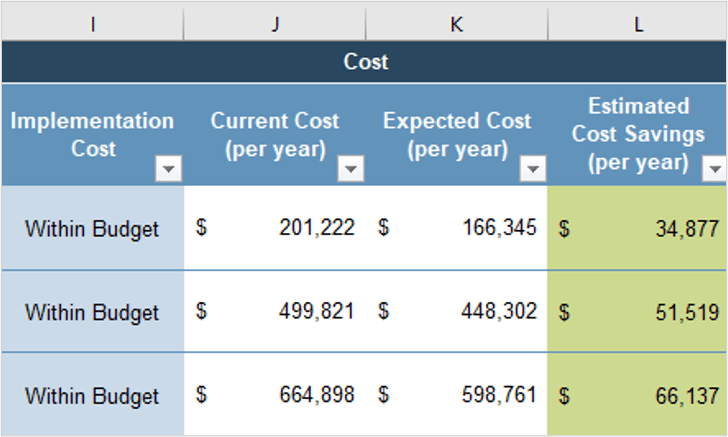
| Column ID | Input Type | Guidelines |
|---|---|---|
| I | Dropdown | Select if the implementation cost is considered within your budget or not. If not, the initiative will be flagged to be reviewed, and no further entry is required; move to the next initiative. Implementation cost represents your cost for planning, executing, and monitoring the related initiative. |
| J, K | Whole Number | Input a dollar amount. Current cost represents the yearly cost including implementing the initiative, while the expected cost represents the yearly cost after implementing the initiative. |
| L | Formula | Automatic calculation, no entry required. The difference between current cost and expected cost. |
Complete the following fields for each initiative in the Excel Workbook as per guidelines:
- Navigate to the Outline Initiatives tab.
- Determine if the implementation cost is considered within the budget.
- If yes, estimate the current cost, and expected cost of the underlying initiative.
2.2.3 Estimate the costs impacting your project portfolio optimization initiatives
2 hours
- Review each project portfolio optimization initiative to estimate cost implications.
- Consider implementation cost in terms of your budget, and document it in the IT Cost Optimization Workbook (see next slides). Is the implementation cost of the underlying initiative considered in your current budget? If not, move to the next initiative. You will assess the flagged initiative independently at a later stage if deemed necessary.
- Estimate the current cost related to the initiative (including implementation cost), and document it in the IT Cost Optimization Workbook (see next slides). This will be the first of two inputs needed to calculate the initiative's potential cost savings.
- Estimate the expected cost, post initiative execution, of the underlying initiative, and document it in the IT Cost Optimization Workbook (see next slides). This will be the second and last input needed to calculate the initiative's potential cost savings.
Download the IT Cost Optimization Workbook
| Input | Output |
|---|---|
|
|
| Materials | Participants |
|
|
Template & Example
Estimate your cost
Excel Workbook: IT Cost Optimization – Outline Initiatives Worksheet
Refer to the example and guidelines below on how to complete cost estimates for each project portfolio optimization initiative:
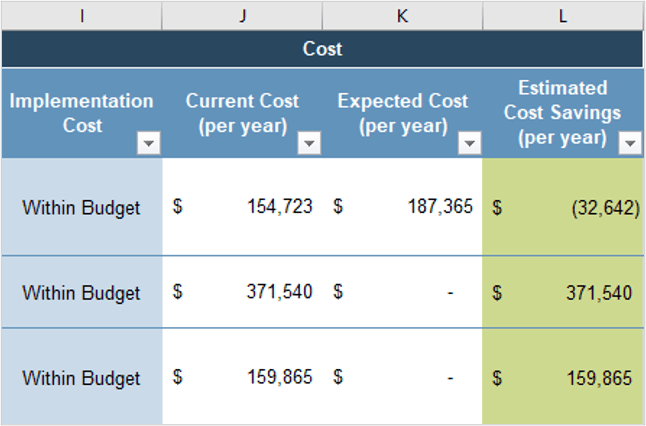
| Column ID | Input Type | Guidelines |
|---|---|---|
| I | Dropdown | Select if the implementation cost is considered within your budget or not. If not, the initiative will be flagged to be reviewed, and no further entry is required; move to the next initiative. Implementation cost represents your cost for planning, executing, and monitoring the related initiative. |
| J, K | Whole Number | Input a dollar amount. Current cost represents the yearly cost including implementing the initiative, while the expected cost represents the yearly cost after implementing the initiative. |
| L | Formula | Automatic calculation, no entry required. The difference between current cost and expected cost. |
Complete the following fields for each initiative in the Excel Workbook as per guidelines:
- Navigate to the Outline Initiatives tab.
- Determine if the implementation cost is considered within the budget.
- If yes, estimate the current cost, and expected cost of the underlying initiative.
2.2.4 Estimate the costs impacting your workforce optimization initiatives
2 hours
- Review each workforce optimization initiative to estimate cost implications.
- Consider implementation cost in terms of your budget, and document it in the IT Cost Optimization Workbook (see next slides). Is the implementation cost of the underlying initiative considered in your current budget? If not, move to the next initiative. You will assess the flagged initiative independently at a later stage if deemed necessary.
- Estimate the current cost related to the initiative (including implementation cost), and document it in the IT Cost Optimization Workbook (see next slides). This will be the first of two inputs needed to calculate the initiative's potential cost savings.
- Estimate the expected cost, post initiative execution, of the underlying initiative, and document it in the IT Cost Optimization Workbook (see next slides). This will be the second and last input needed to calculate the initiative's potential cost savings.
Download the IT Cost Optimization Workbook
| Input | Output |
|---|---|
|
|
| Materials | Participants |
|
|
Template & Example
Estimate your cost
Excel Workbook: IT Cost Optimization –i Outline Initiatives Worksheet
Refer to the example and guidelines below on how to complete cost estimates for each workforce optimization initiative:
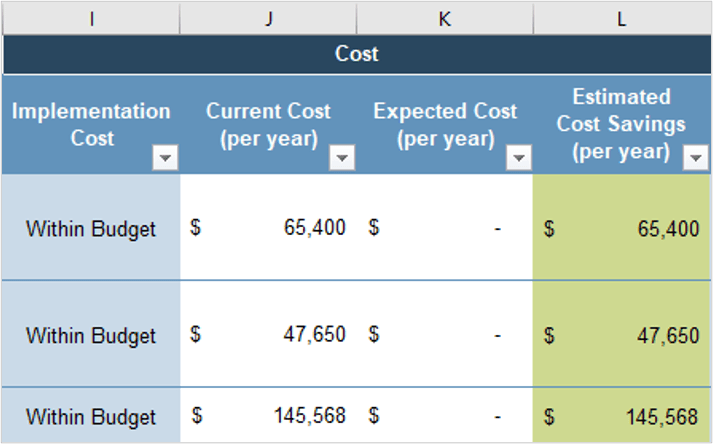
| Column ID | Input Type | Guidelines |
|---|---|---|
| I | Dropdown | Select if the implementation cost is considered within your budget or not. If not, the initiative will be flagged to be reviewed, and no further entry is required; move to the next initiative. Implementation cost represents your cost for planning, executing, and monitoring the related initiative. |
| J, K | Whole Number | Input a dollar amount. Current cost represents the yearly cost including implementing the initiative, while the expected cost represents the yearly cost after implementing the initiative. |
| L | Formula | Automatic calculation, no entry required. The difference between current cost and expected cost. |
Complete the following fields for each initiative in the Excel Workbook as per guidelines:
- Navigate to the Outline Initiatives tab.
- Determine if the implementation cost is considered within the budget.
- If yes, estimate the current cost, and expected cost of the underlying initiative.
Phase 3
Develop Your IT Cost Optimization Roadmap
Phase 1
Understand Your Mandate and Objectives
Phase 2
Outline Your Cost Optimization Initiatives
Phase 3
Develop Your IT Cost Optimization Roadmap
Phase 4
Communicate and Execute
This phase will walk you through the following activities:
- IT cost optimization workbook
- IT cost optimization roadmap
This phase involves the following participants:
- CIO/IT director
- IT finance lead
- IT asset manager
- IT infrastructure manager
- IT vendor management lead
- PMO lead
- IT talent management representative
- Other IT management
Develop your prioritized and aligned cost optimization roadmap
The process of developing your roadmap is where you set final cost optimization priorities, conduct a final rationalization to decide what's in and what's out, and document your proposed plan of action.
First, take a moment to consider if you missed anything. Too often, only the cost cutting elements of the cost optimization equation get attention. Remember that cost optimization also includes making smart investments. Sometimes adding and expanding is better for the business than removing or contracting.
- Do your proposed initiatives help position the organization to recover quickly if you're dealing with a downturn or recession scenario?
- Have you fully considered growth or innovation opportunities that will help optimize costs in the long run?
Feasibility
Eliminate initiatives from the longlist of potential initiatives that cannot be achieved given the cost optimization goals you determined at the beginning of this exercise.
Priority
Rank order the remaining initiatives according to their ability to contribute to goal attainment and dependency relationships with external constraints and one another.
Action Plan
Create an overarching visual roadmap that shows how you intend to achieve your cost optimization goals over the short, medium, and long-term.
3.1 Assess the feasibility of your cost optimization initiatives
4 hours
Now that you have identified your initiatives across the four levers and understood the business impacts:
- Review each of your cost optimization initiatives and estimate the feasibility in terms of:
- Effort required to implement.
- Risk: Likelihood of failure and impact on performance.
- Approval rights: Within the IT or finance's accountability/domain or not.
- Document your assessment in the IT Cost Optimization Workbook.
Download the IT Cost Optimization Workbook
| Input | Output |
|---|---|
|
|
| Materials | Participants |
|
|
3.1.1 Estimate the feasibility of your asset optimization initiatives
1 hour
- Review each asset optimization initiative to estimate feasibility implications.
- Start by defining the effort required variables. Think in terms of how many dedicated full-time employees you would need to implement the initiative. Document your definition for each of the three variables (High, Medium, or Low) in the IT Cost Optimization Workbook (see next slides). Then, estimate the effort required to implement the related initiative. Consider complexity, scope, and resource availability, before you document it in the IT Cost Optimization Workbook (see next slides).
- Define your likelihood of failure variables. Think in terms of probability of failure or percent chance the underlying initiative will not succeed. Document your definition for each of the three variables (High, Medium, or Low) in the IT Cost Optimization Workbook (see next slides). Then, estimate the likelihood of failure to implement the related initiative, and document it in the IT Cost Optimization Workbook (see next slides).
- Consider the initiative's impact on performance. Would implementing the initiative hinder IT or business performance? If you are on a reactive journey, would it impede business recovery in any way, shape, or form? Document the impact (Positive Impact, No Impact, or Negative Impact) in the IT Cost Optimization Workbook (see next slides).
- Determine who is responsible for approving the initiative. Does it fall within your jurisdiction, responsibility, or accountability? If not, it would mean that it might be more difficult to implement the initiative. Document approval rights (within accountability or not within accountability) in the IT Cost Optimization Workbook (see next slides).
Download the IT Cost Optimization Workbook
| Input | Output |
|---|---|
|
|
| Materials | Participants |
|
|
Template & Example
Define your feasibility variables
Excel Workbook: IT Cost Optimization – Define Variables Worksheet
Refer to the example and guidelines below on how to define your feasibility variables for standardization purposes. You can adopt a different definition per optimization lever (Assets, Vendors, Project Portfolio, and Workforce), or maintain the same one across initiatives, depending on what makes sense for your organization:

| Column ID | Input Type | Guidelines |
|---|---|---|
| B, G | Formula | Automatic calculation, no entry required. The ID will populate automatically. |
| C, H | Text | No entry required. Three variables identified: High, Medium, Low. |
| D, E | Whole Number | Review and input the range of each effort required variable, based on the number of dedicated full-time employees needed to implement an initiative, as it works best for your organization. |
| I, J | Whole Number | Review and input the range of each likelihood of failure variable, based on the probability of failure of an initiative, as it works best for your organization. This example should work for most organizations. |
Define your feasibility variables in the Excel Workbook as per guidelines:
- Navigate to the Define Variables tab.
- Review and enter the range of each effort required and likelihood of failure variable as you see fit for your organization.
Template & Example
Estimate your feasibility
Excel Workbook: IT Cost Optimization – Outline Initiatives Worksheet
Refer to the example and guidelines below on how to complete feasibility estimates for each asset optimization initiative:
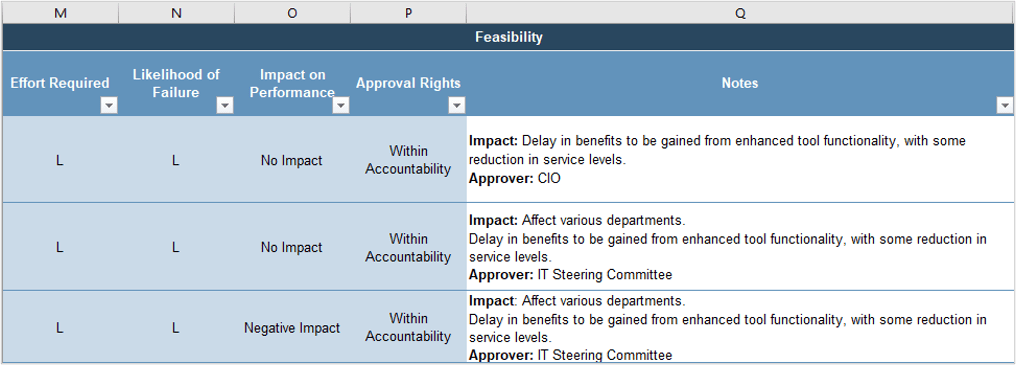
| Column ID | Input Type | Guidelines |
|---|---|---|
| M | Dropdown | Select the effort required estimate based on your defined variables. Effort required represents the number of dedicated employees needed to plan, execute, and monitor the underlying initiative, based on the level of maturity and readiness; consider complexity, scope, and resource availability. |
| N | Dropdown | Select the likelihood of failure estimate based on your defined variables. Likelihood of failure represents the probability of failure of the underlying initiative. |
| O | Dropdown | Select the impact on performance estimate related to the implementation of the underlying initiative. Consider the impact on IT and on business (including business recovery if on a reactive journey). |
| P | Dropdown | Select the appropriate approval right related to the underlying initiative. Determine if the initiative's approval falls within your accountability or not. |
| Q | Text | Write a brief description per initiative, providing an impact rationale and identifying the approver where possible. |
Complete the following fields for each initiative in the Excel Workbook as per guidelines:
- Navigate to the Outline Initiatives tab.
- Determine the appropriate effort required to implement the underlying initiative.
- Identify the risk of each initiative: likelihood of failure and impact on performance.
- Choose the adequate approval right classification for each initiative.
3.1.2 Estimate the feasibility of your vendor optimization initiatives
1 hour
- Review each vendor optimization initiative to estimate feasibility implications, along with previously defined variables (see slides 64 and 65).
- Consider the initiative's impact on performance. Would implementing the initiative hinder IT or business performance? If you are on a reactive journey, would it impede business recovery in any way, shape, or form? Document the impact (Positive Impact, No Impact, or Negative Impact) in the IT Cost Optimization Workbook (see next slides).
- Determine who is responsible for approving the initiative. Does it fall within your jurisdiction, responsibility, or accountability? If not, it would mean that it might be more difficult to implement the initiative. Document approval rights (within accountability or not within accountability) in the IT Cost Optimization Workbook (see next slides).
Download the IT Cost Optimization Workbook
| Input | Output |
|---|---|
|
|
| Materials | Participants |
|
|
Template & Example
Estimate your feasibility
Excel Workbook: IT Cost Optimization – Outline Initiatives Worksheet
Refer to the example and guidelines below on how to complete feasibility estimates for each vendor optimization initiative:

| Column ID | Input Type | Guidelines |
|---|---|---|
| M | Dropdown | Select the effort required estimate based on your defined variables. Effort required represents the number of dedicated employees needed to plan, execute, and monitor the underlying initiative, based on the level of maturity and readiness; consider complexity, scope, and resource availability. |
| N | Dropdown | Select the likelihood of failure estimate based on your defined variables. Likelihood of failure represents the probability of failure of the underlying initiative. |
| O | Dropdown | Select the impact on performance estimate related to the implementation of the underlying initiative. Consider the impact on IT and on business (including business recovery if on a reactive journey). |
| P | Dropdown | Select the appropriate approval right related to the underlying initiative. Determine if the initiative's approval falls within your accountability or not. |
| Q | Text | Write a brief description per initiative, providing an impact rationale and identifying the approver where possible. |
Complete the following fields for each initiative in the Excel Workbook as per guidelines:
- Navigate to the Outline Initiatives tab.
- Determine the appropriate effort required to implement the underlying initiative.
- Identify the risk of each initiative: likelihood of failure and impact on performance.
- Choose the adequate approval right classification for each initiative.
3.1.3 Estimate the feasibility of your project portfolio optimization initiatives
1 hour
- Review each project portfolio optimization initiative to estimate feasibility implications, along with previously defined variables (see slides 64 and 65).
- Consider the initiative's impact on performance. Would implementing the initiative hinder IT or business performance? If you are on a reactive journey, would it impede business recovery in any way, shape, or form? Document the impact (Positive Impact, No Impact, or Negative Impact) in the IT Cost Optimization Workbook (see next slides).
- Determine who is responsible for approving the initiative. Does it fall within your jurisdiction, responsibility, or accountability? If not, it would mean that it might be more difficult to implement the initiative. Document approval rights (within accountability or not within accountability) in the IT Cost Optimization Workbook (see next slides).
Download the IT Cost Optimization Workbook
| Input | Output |
|---|---|
|
|
| Materials | Participants |
|
|
Template & Example
Estimate your feasibility
Excel Workbook: IT Cost Optimization – Outline Initiatives Worksheet
Refer to the example and guidelines below on how to complete feasibility estimates for each project portfolio optimization initiative:

| Column ID | Input Type | Guidelines |
|---|---|---|
| M | Dropdown | Select the effort required estimate based on your defined variables. Effort required represents the number of dedicated employees needed to plan, execute, and monitor the underlying initiative, based on the level of maturity and readiness; consider complexity, scope, and resource availability. |
| N | Dropdown | Select the likelihood of failure estimate based on your defined variables. Likelihood of failure represents the probability of failure of the underlying initiative. |
| O | Dropdown | Select the impact on performance estimate related to the implementation of the underlying initiative. Consider the impact on IT and on business (including business recovery if on a reactive journey). |
| P | Dropdown | Select the appropriate approval right related to the underlying initiative. Determine if the initiative's approval falls within your accountability or not. |
| Q | Text | Write a brief description per initiative, providing an impact rationale and identifying the approver where possible. |
Complete the following fields for each initiative in the Excel Workbook as per guidelines:
- Navigate to the Outline Initiatives tab.
- Determine the appropriate effort required to implement the underlying initiative.
- Identify the risk of each initiative: likelihood of failure and impact on performance.
- Choose the adequate approval right classification for each initiative.
3.1.4 Estimate the feasibility of your workforce optimization initiatives
1 hour
- Review each workforce optimization initiative to estimate feasibility implications, along with previously defined variables (see slides 64 and 65).
- Consider the initiative's impact on performance. Would implementing the initiative hinder IT or business performance? If you are on a reactive journey, would it impede business recovery in any way, shape, or form? Document the impact (Positive Impact, No Impact, or Negative Impact) in the IT Cost Optimization Workbook (see next slides).
- Determine who is responsible for approving the initiative. Does it fall within your jurisdiction, responsibility, or accountability? If not, it would mean that it might be more difficult to implement the initiative. Document approval rights (within accountability or not within accountability) in the IT Cost Optimization Workbook (see next slides).
Download the IT Cost Optimization Workbook
| Input | Output |
|---|---|
|
|
| Materials | Participants |
|
|
Template & Example
Estimate your feasibility
Excel Workbook: IT Cost Optimization – Outline Initiatives Worksheet
Refer to the example and guidelines below on how to complete feasibility estimates for each workforce optimization initiative:

| Column ID | Input Type | Guidelines |
|---|---|---|
| M | Dropdown | Select the effort required estimate based on your defined variables. Effort required represents the number of dedicated employees needed to plan, execute, and monitor the underlying initiative, based on the level of maturity and readiness; consider complexity, scope, and resource availability. |
| N | Dropdown | Select the likelihood of failure estimate based on your defined variables. Likelihood of failure represents the probability of failure of the underlying initiative. |
| O | Dropdown | Select the impact on performance estimate related to the implementation of the underlying initiative. Consider the impact on IT and on business (including business recovery if on a reactive journey). |
| P | Dropdown | Select the appropriate approval right related to the underlying initiative. Determine if the initiative's approval falls within your accountability or not. |
| Q | Text | Write a brief description per initiative, providing an impact rationale and identifying the approver where possible. |
Complete the following fields for each initiative in the Excel Workbook as per guidelines:
- Navigate to the Outline Initiatives tab.
- Determine the appropriate effort required to implement the underlying initiative.
- Identify the risk of each initiative: likelihood of failure and impact on performance.
- Choose the adequate approval right classification for each initiative.
3.2 Prioritize cost optimization initiatives to create a final shortlist
4 hours
Now that you have your cost and feasibility for each cost optimization initiative:
- Review each of your cost optimization initiatives and estimate the time and priority by considering:
- Preliminary priority assessment based on your cost and feasibility input.
- Time frame: start and end date of each initiative.
- Current budget cycle: time remaining in the current budget cycle and potential cost savings in this fiscal year.
- Determine the final priority of the initiative and decide whether you want to include it in your 12-month roadmap.
- Document your assessment in the IT Cost Optimization Workbook.
Download the IT Cost Optimization Workbook
| Input | Output |
|---|---|
|
|
| Materials | Participants |
|
|
3.2.1 Prioritize your asset optimization initiatives
1 hour
- Review each asset optimization initiative to set the priority.
- Validate your cost and feasibility estimates and consider the automated evaluation, in the IT Cost Optimization Workbook, providing you with a preliminary priority based on your cost and feasibility estimates (see next slides).
- Revisit your overarching goals (step 1.4) as you will assess the time it will take you to complete your initiatives and prioritize accordingly.
- Determine your start and end date for each initiative based on your journey, objectives, and overarching goals. Consider the urgency of each initiative. Document the quarter and year for your start and end dates in the IT Cost Optimization Workbook (see next slides).
- Identify the time remaining in your current budget cycle after the completion of each initiative to get a cost savings estimate for the current fiscal year. Document the number of remaining quarters (0, 1, 2, 3, or 4) in the IT Cost Optimization Workbook (see next slides).
- Decide on the priority of each initiative (High, Medium, or Low), and document it in the IT Cost Optimization Workbook (see next slides).
- Revisit the priority decision after prioritizing all your initiatives and determine which ones to include in your 12-month roadmap; consider the number of initiatives you can tackle at the same time within a 12-month period. Document your final decision (Yes or No) in the IT Cost Optimization Workbook (see next slides).
Download the IT Cost Optimization Workbook
| Input | Output |
|---|---|
|
|
| Materials | Participants |
|
|
Template & Example
Understand your priority assessment
Excel Workbook: IT Cost Optimization – Outline Initiatives Worksheet
Refer to the example and guidelines below on how the preliminary priority assessment is assigned, for each asset optimization initiative, noting that columns Q to X are hidden automatic calculations and should not be touched:
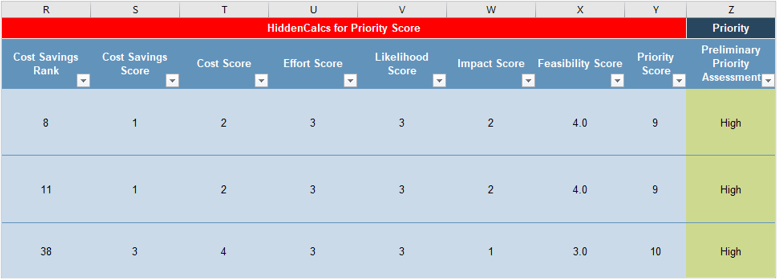
| Column ID | Input Type | Guidelines |
|---|---|---|
| R | Formula | Hidden automatic calculation, no entry required. Rank of estimate cost savings (per year) in ascending order (higher cost savings implies a higher rank). |
| S | Formula | Hidden automatic calculation, no entry required. Cost Savings Score on a scale of 1 to 3, where the top third in Cost Savings Rank are assigned a score of 1, the bottom third a score of 3, and in between a score of 2, noting that negative cost savings would imply a -1 score. |
| T | Formula | Hidden automatic calculation, no entry required. Cost Score adds 1 to the Cost Savings Score if the underlying initiative is within the budget. |
| U, V, W | Formula | Hidden automatic calculation, no entry required. A score on a scale of 1 to 3 based on input of columns M, N, and O, where Low or Positive Impact is assigned a score of 3, Medium or No Impact a score of 2, and High or Negative Impact a score of 1. |
| X | Formula | Hidden automatic calculation, no entry required. The rounding of the average of columns U, V, and W, adding 1 to the result if the initiative's approval falls within your accountability (column P). |
| Y | Formula | Hidden automatic calculation, no entry required. The sum of columns T and X, adding 3 for Reduce Unwarranted IT Spending, and 1 to Optimize Cost-to-value (column H). |
| Z | Formula | Hidden automatic calculation, no entry required. Preliminary priority assessment based on the Define Priority Threshold worksheet (hidden, see next slide). |
Review the following fields for each initiative in the Excel Workbook as per guidelines:
- Navigate to the Outline Initiatives tab.
- Validate cost and feasibility estimates (columns I to P previously filled - steps 2.2 and 3.1) driving the Priority Score and Preliminary Priority Assessment.
Template & Example
Priority threshold rationale
Excel Workbook: IT Cost Optimization – Define Priority Threshold Worksheet
Refer to the screenshot of the Define Priority Threshold worksheet below to understand the rationale behind the priority score and priority level:
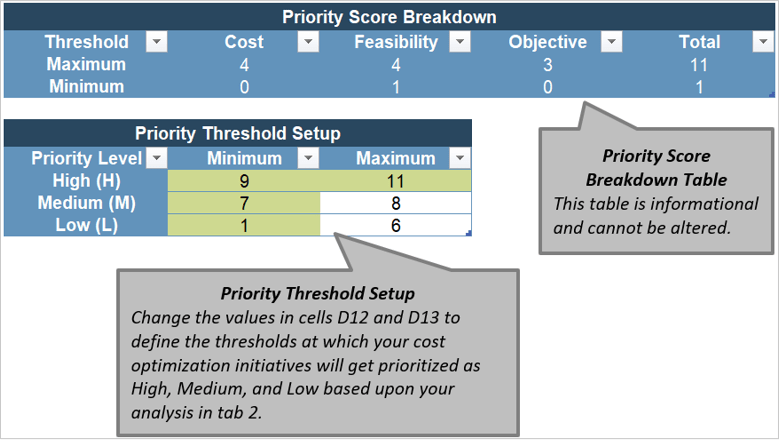
Template & Example
Estimate your timeline
Excel Workbook: IT Cost Optimization – Outline Initiatives Worksheet
Refer to the example and guidelines below on how to complete timeline estimates for each asset optimization initiative:
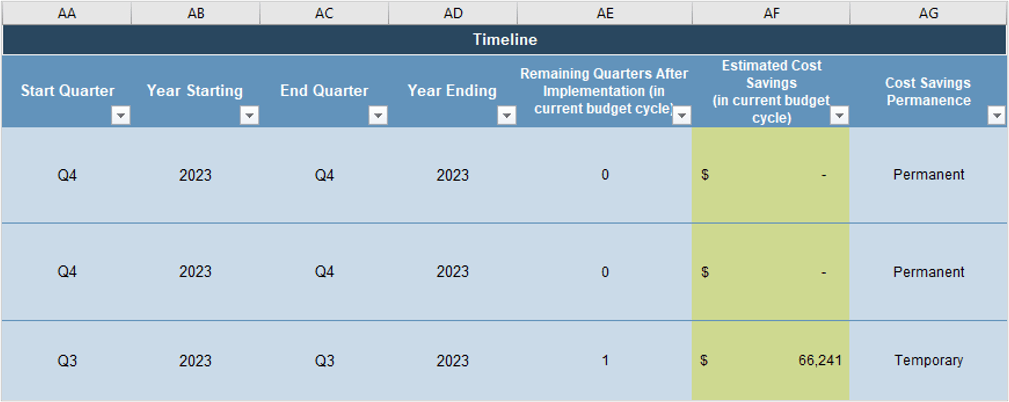
| Column ID | Input Type | Guidelines |
|---|---|---|
| AA, AC | Dropdown | Select the quarter(s) in which you plan to begin and complete your initiative. |
| AB, AD | Dropdown | Select the year(s) in which you plan to begin and complete your initiative. |
| AE | Dropdown | Select the number of remaining quarters, in the current fiscal year, after you complete the initiative (0 to 4); based on columns AA to AD. |
| AF | Formula | Automatic calculation, no entry required. Estimate of cost savings in the current fiscal year, based on the remaining quarters after implementation. The entry in column AE is divided by 4, and the result is multiplied by the related estimated cost savings per year (entry in column L). |
| AG | Dropdown | Select if cost savings after the implementation of the underlying initiative will be permanent or temporary. |
Complete the following fields for each initiative in the Excel Workbook as per guidelines:
- Navigate to the Outline Initiatives tab.
- Determine the appropriate quarter and year to start and complete the initiative.
- Identify the time remaining in your current budget cycle after the completion of the initiative.
Template & Example
Make your final decisions
Excel Workbook: IT Cost Optimization – Outline Initiatives Worksheet
Refer to the example and guidelines below on how to assign the final priority for each asset optimization initiative, and include it in your 12-month roadmap:
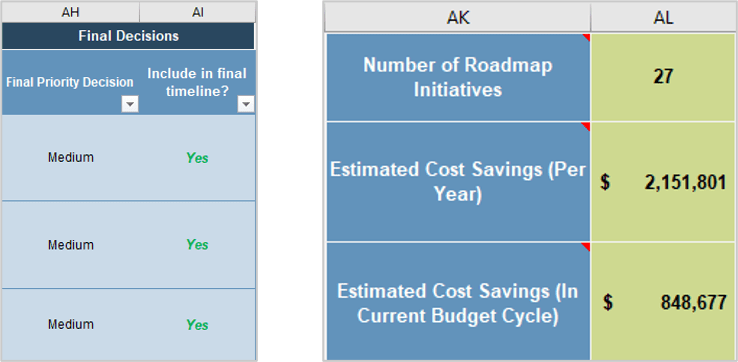
| Column ID | Row ID | Input Type | Guidelines |
|---|---|---|---|
| AH | - | Dropdown | Select your final priority decision after reviewing the preliminary priority assessment (column Z) and timeline estimates (columns AA to AG). |
| AI | - | Dropdown | Select whether you want to include the initiative in your 12-month roadmap (Yes or No). |
| AK, AL | 5 | Formula | Automatic calculation, no entry required. The total number of initiatives you decided to include in your 12-month roadmap; based on column AI when Yes is selected. |
| AK, AL | 6 | Formula | Automatic calculation, no entry required. Total estimated cost savings per year after the initiative's completion; based on column L when included in the 12-month roadmap (column AI when Yes is selected) |
| AK, AL | 7 | Formula | Automatic calculation, no entry required. Total estimated cost savings in the current fiscal year; based on column AF when included in the 12-month roadmap (column AI when Yes is selected) |
- Estimated cost savings per year refer to cost savings fully realized by the end of the upcoming fiscal year, following the initiatives' implementation.
- Estimated cost savings in the current budget cycle, refer to cost savings partially realized in the current fiscal year, after the initiatives' implementation.
Complete the following fields for each initiative in the Excel Workbook as per guidelines:
- Navigate to the Outline Initiatives tab.
- Determine the final priority of the initiative.
- Decide whether you want to include the initiative in your 12-month roadmap.
3.2.2 Prioritize your vendor optimization initiatives
1 hour
- Review each vendor optimization initiative to set the priority.
- Validate your cost and feasibility estimates and consider the automated evaluation, in the IT Cost Optimization Workbook, providing you with a preliminary priority based on your cost and feasibility estimates (see next slides).
- Revisit your overarching goals (step 1.4) as you will assess the time it will take you to complete your initiatives and prioritize accordingly.
- Determine your start and end date for each initiative based on your journey, objectives, and overarching goals. Consider the urgency of each initiative. Document the quarter and year for your start and end dates in the IT Cost Optimization Workbook (see next slides).
- Identify the time remaining in your current budget cycle after the completion of each initiative to get a cost savings estimate for the current fiscal year. Document the number of remaining quarters (0, 1, 2, 3, or 4) in the IT Cost Optimization Workbook (see next slides).
- Decide on the priority of each initiative (High, Medium, or Low), and document it in the IT Cost Optimization Workbook (see next slides).
- Revisit the priority decision after prioritizing all your initiatives and determine which ones to include in your 12-month roadmap; consider the number of initiatives you can tackle at the same time within a 12-month period. Document your final decision (Yes or No) in the IT Cost Optimization Workbook (see next slides).
Download the IT Cost Optimization Workbook
| Input | Output |
|---|---|
|
|
| Materials | Participants |
|
|
Template & Example
Understand your priority assessment
Excel Workbook: IT Cost Optimization – Outline Initiatives Worksheet
Refer to the example and guidelines below on how the preliminary priority assessment is assigned, for each vendor optimization initiative, noting that columns Q to X are hidden automatic calculations and should not be touched:

| Column ID | Input Type | Guidelines | |
|---|---|---|---|
| R | Formula | Hidden automatic calculation, no entry required. Rank of estimate cost savings (per year) in ascending order (higher cost savings implies a higher rank). | |
| S | Formula | Hidden automatic calculation, no entry required. Cost Savings Score on a scale of 1 to 3, where the top third in Cost Savings Rank are assigned a score of 1, the bottom third a score of 3, and in between a score of 2, noting that negative cost savings would imply a -1 score. | |
| T | Formula | Hidden automatic calculation, no entry required. Cost Score adds 1 to the Cost Savings Score if the underlying initiative is within the budget. | |
| U, V, W | Formula | Hidden automatic calculation, no entry required. A score on a scale of 1 to 3 based on input of columns M, N, and O, where Low or Positive Impact is assigned a score of 3, Medium or No Impact a score of 2, and High or Negative Impact a score of 1. | |
| X | Formula | Hidden automatic calculation, no entry required. The rounding of the average of columns U, V, and W, adding 1 to the result if the initiative's approval falls within your accountability (column P). | |
| Y | Formula | Hidden automatic calculation, no entry required. The sum of columns T and X, adding 3 for Reduce Unwarranted IT Spending, and 1 to Optimize Cost-to-Value (column H). | |
| Z | Formula | Hidden automatic calculation, no entry required. Preliminary priority assessment based on the Define Priority Threshold worksheet (hidden, see next slide). |
Review the following fields for each initiative in the Excel Workbook as per guidelines:
- Navigate to the Outline Initiatives tab.
- Validate cost and feasibility estimates (columns I to P previously filled - steps 2.2 and 3.1) driving the Priority Score and Preliminary Priority Assessment.
Template & Example
Priority Threshold Rationale
Excel Workbook: IT Cost Optimization – Define Priority Threshold Worksheet
Refer to the screenshot of the Define Priority Threshold worksheet below to understand the rationale behind the Priority Score and Priority Level:
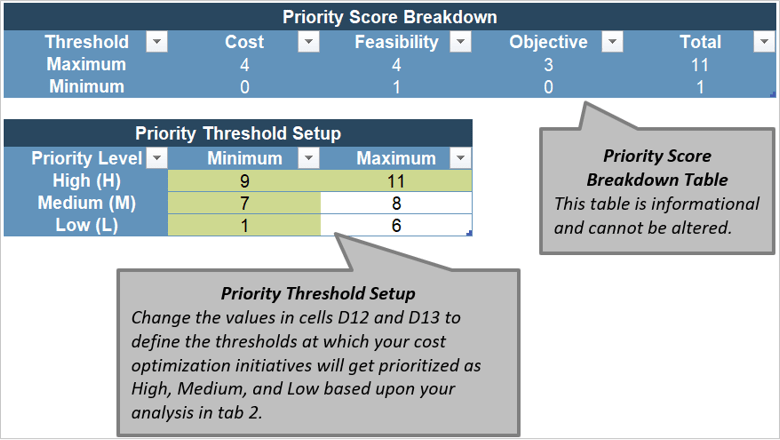
Template & Example
Estimate your timeline
Excel Workbook: IT Cost Optimization – Outline Initiatives Worksheet
Refer to the example and guidelines below on how to complete timeline estimates for each vendor optimization initiative:

| Column ID | Input Type | Guidelines |
|---|---|---|
| AA, AC | Dropdown | Select the quarter(s) in which you plan to begin and complete your initiative. |
| AB, AD | Dropdown | Select the year(s) in which you plan to begin and complete your initiative. |
| AE | Dropdown | Select the number of remaining quarters, in the current fiscal year, after you complete the initiative (0 to 4); based on columns AA to AD. |
| AF | Formula | Automatic calculation, no entry required. Estimate of cost savings in the current fiscal year, based on the remaining quarters after implementation. The entry in column AE is divided by 4, and the result is multiplied by the related estimated cost savings per year (entry in column L). |
| AG | Dropdown | Select if cost savings after the implementation of the underlying initiative will be Permanent or Temporary. |
Complete the following fields for each initiative in the Excel Workbook as per guidelines:
- Navigate to the Outline Initiatives tab.
- Determine the appropriate quarter and year to start and complete the initiative.
- Identify the time remaining in your current budget cycle after the completion of the initiative.
Template & Example
Make your final decisions
Excel Workbook: IT Cost Optimization - Outline Initiatives Worksheet
Refer to the example and guidelines below on how to assign the final priority for each vendor optimization initiative, and include it in your 12-month roadmap:
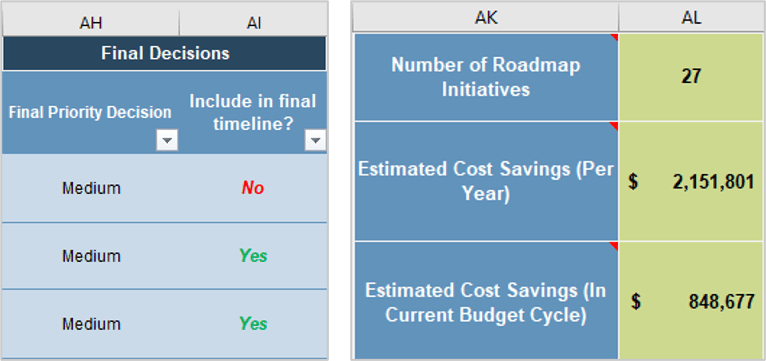
| Column ID | Row ID | Input Type | Guidelines |
|---|---|---|---|
| AH | - | Dropdown | Select your final priority decision after reviewing the preliminary priority assessment (column Z) and timeline estimates (columns AA to AG). |
| AI | - | Dropdown | Select whether you want to include the initiative in your 12-month roadmap (Yes or No). |
| AK, AL | 5 | Formula | Automatic calculation, no entry required. The total number of initiatives you decided to include in your 12-month roadmap; based on column AI when Yes is selected. |
| AK, AL | 6 | Formula | Automatic calculation, no entry required. Total estimated cost savings per year after the initiative's completion; based on column L when included in the 12-month roadmap (column AI when Yes is selected) |
| AK, AL | 7 | Formula | Automatic calculation, no entry required. Total estimated cost savings in the current fiscal year; based on column AF when included in the 12-month roadmap (column AI when Yes is selected) |
- Estimated cost savings per year refer to cost savings fully realized by the end of the upcoming fiscal year, following the initiatives' implementation.
- Estimated cost savings in the current budget cycle, refer to cost savings partially realized in the current fiscal year, after the initiatives' implementation.
Complete the following fields for each initiative in the Excel Workbook as per guidelines:
- Navigate to the Outline Initiatives tab.
- Determine the final priority of the initiative.
- Decide whether you want to include the initiative in your 12-month roadmap.
3.2.3 Prioritize your project portfolio optimization initiatives
1 hour
- Review each project portfolio optimization initiative to set the priority.
- Validate your cost and feasibility estimates and consider the automated evaluation, in the IT Cost Optimization Workbook, providing you with a preliminary priority based on your cost and feasibility estimates (see next slides).
- Revisit your overarching goals (step 1.4) as you will assess the time it will take you to complete your initiatives and prioritize accordingly.
- Determine your start and end date for each initiative based on your journey, objectives, and overarching goals. Consider the urgency of each initiative. Document the quarter and year for your start and end dates in the IT Cost Optimization Workbook (see next slides).
- Identify the time remaining in your current budget cycle after the completion of each initiative to get a cost savings estimate for the current fiscal year. Document the number of remaining quarters (0, 1, 2, 3, or 4) in the IT Cost Optimization Workbook (see next slides).
- Decide on the priority of each initiative (High, Medium, or Low), and document it in the IT Cost Optimization Workbook (see next slides).
- Revisit the priority decision after prioritizing all your initiatives and determine which ones to include in your 12-month roadmap; consider the number of initiatives you can tackle at the same time within a 12-month period. Document your final decision (Yes or No) in the IT Cost Optimization Workbook (see next slides).
Download the IT Cost Optimization Workbook
| Input | Output |
|---|---|
|
|
| Materials | Participants |
|
|
Template & Example
Understand your priority assessment
Excel Workbook: IT Cost Optimization - Outline Initiatives Worksheet
Refer to the example and guidelines below on how the preliminary priority assessment is assigned, for each project portfolio optimization initiative, noting that columns Q to X are hidden automatic calculations and should not be touched:
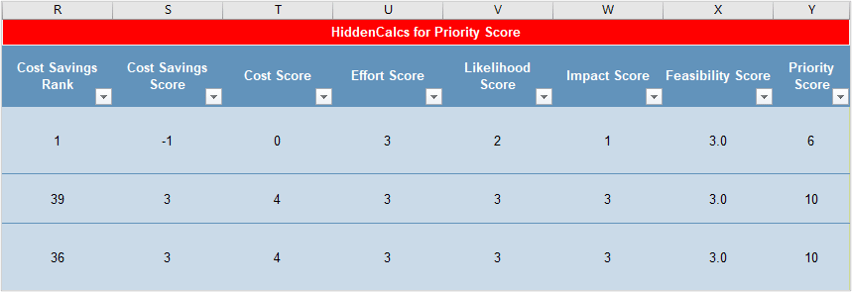
| Column ID | Input Type | Guidelines |
|---|---|---|
| R | Formula | Hidden automatic calculation, no entry required. Rank of Estimate Cost Savings (per year) in ascending order (higher cost savings implies a higher rank). |
| S | Formula | Hidden automatic calculation, no entry required. Cost Savings Score on a scale of 1 to 3, where the top third in Cost Savings Rank are assigned a score of 1, the bottom third a score of 3, and in between a score of 2, noting that negative cost savings would imply a -1 score. |
| T | Formula | Hidden automatic calculation, no entry required. Cost Score adds 1 to the Cost Savings Score if the underlying initiative is within the budget. |
| U, V, W | Formula | Hidden automatic calculation, no entry required. A score on a scale of 1 to 3 based on input of columns M, N, and O, where Low or Positive Impact is assigned a score of 3, Medium or No Impact a score of 2, and High or Negative Impact a score of 1. |
| X | Formula | Hidden automatic calculation, no entry required. The rounding of the average of columns U, V, and W, adding 1 to the result if the initiative's approval falls within your accountability (column P). |
| Y | Formula | Hidden automatic calculation, no entry required. The sum of columns T and X, adding 3 for Reduce Unwarranted IT Spending, and 1 to Optimize Cost-to-Value (column H). |
| Z | Formula | Hidden automatic calculation, no entry required. Preliminary Priority Assessment based on the Define Priority Threshold worksheet (hidden, see next slide). |
Review the following fields for each initiative in the Excel Workbook as per guidelines:
- Navigate to the Outline Initiatives tab.
- Validate cost and feasibility estimates (columns I to P previously filled - steps 2.2 and 3.1) driving the Priority Score and Preliminary Priority Assessment.
Template & Example
Priority Threshold Rationale
Excel Workbook: IT Cost Optimization - Define Priority Threshold Worksheet
Refer to the screenshot of the Define Priority Threshold worksheet below to understand the rationale behind the Priority Score and Priority Level:
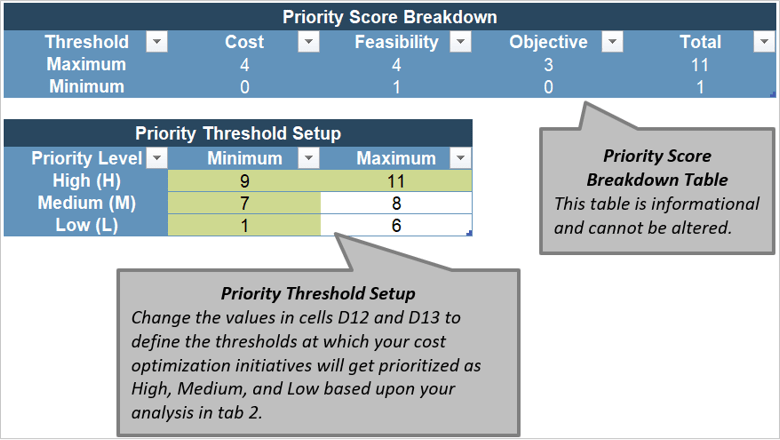
Template & Example
Estimate your timeline
Excel Workbook: IT Cost Optimization - Outline Initiatives Worksheet
Refer to the example and guidelines below on how to complete timeline estimates for each project portfolio optimization initiative:
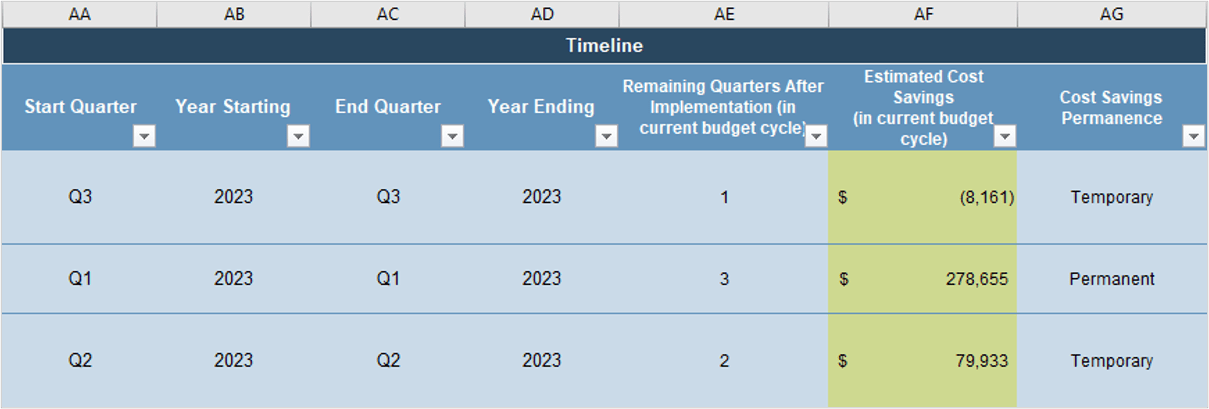
| Column ID | Input Type | Guidelines |
|---|---|---|
| AA, AC | Dropdown | Select the quarter(s) in which you plan to begin and complete your initiative. |
| AB, AD | Dropdown | Select the year(s) in which you plan to begin and complete your initiative. |
| AE | Dropdown | Select the number of remaining quarters, in the current fiscal year, after you complete the initiative (0 to 4); based on columns AA to AD. |
| AF | Formula | Automatic calculation, no entry required. Estimate of cost savings in the current fiscal year, based on the remaining quarters after implementation. The entry in column AE is divided by 4, and the result is multiplied by the related estimated cost savings per year (entry in column L). |
| AG | Dropdown | Select if cost savings after the implementation of the underlying initiative will be Permanent or Temporary. |
Complete the following fields for each initiative in the Excel Workbook as per guidelines:
- Navigate to the Outline Initiatives tab.
- Determine the appropriate quarter and year to start and complete the initiative.
- Identify the time remaining in your current budget cycle after the completion of the initiative.
Template & Example
Make your final decisions
Excel Workbook: IT Cost Optimization - Outline Initiatives Worksheet
Refer to the example and guidelines below on how to assign the final priority for each project portfolio optimization initiative and include it in your 12-month roadmap:
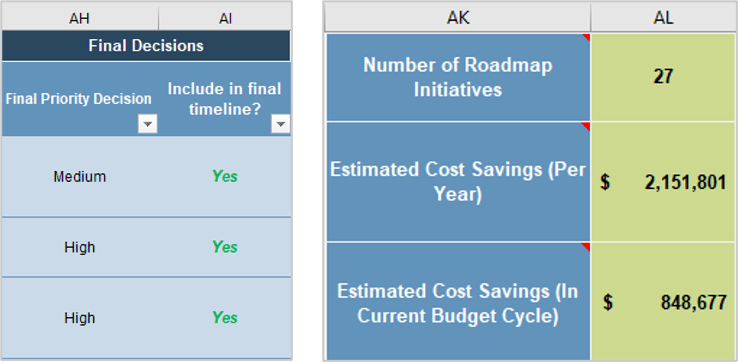
| Column ID | Row ID | Input Type | Guidelines |
|---|---|---|---|
| AH | - | Dropdown | Select your final priority decision after reviewing the preliminary priority assessment (column Z) and timeline estimates (columns AA to AG). |
| AI | - | Dropdown | Select whether you want to include the initiative in your 12-month roadmap (Yes or No). |
| AK, AL | 5 | Formula | Automatic calculation, no entry required. The total number of initiatives you decided to include in your 12-month roadmap; based on column AI when Yes is selected. |
| AK, AL | 6 | Formula | Automatic calculation, no entry required. Total estimated cost savings per year after the initiative's completion; based on column L when included in the 12-month roadmap (column AI when Yes is selected) |
| AK, AL | 7 | Formula | Automatic calculation, no entry required. Total estimated cost savings in the current fiscal year; based on column AF when included in the 12-month roadmap (column AI when Yes is selected) |
- Estimated cost savings per year refer to cost savings fully realized by the end of the upcoming fiscal year, following the initiatives' implementation.
- Estimated cost savings in the current budget cycle, refer to cost savings partially realized in the current fiscal year, after the initiatives' implementation.
Complete the following fields for each initiative in the Excel Workbook as per guidelines:
- Navigate to the Outline Initiatives tab.
- Determine the final priority of the initiative.
- Decide whether you want to include the initiative in your 12-month roadmap.
3.2.4 Prioritize your workforce optimization initiatives
1 hour
- Review each workforce optimization initiative to set the priority.
- Validate your cost and feasibility estimates and consider the automated evaluation, in the IT Cost Optimization Workbook, providing you with a preliminary priority based on your cost and feasibility estimates (see next slides).
- Revisit your overarching goals (step 1.4) as you will assess the time it will take you to complete your initiatives and prioritize accordingly.
- Determine your start and end date for each initiative based on your journey, objectives, and overarching goals. Consider the urgency of each initiative. Document the quarter and year for your start and end dates in the IT Cost Optimization Workbook (see next slides).
- Identify the time remaining in your current budget cycle after the completion of each initiative to get a cost savings estimate for the current fiscal year. Document the number of remaining quarters (0, 1, 2, 3, or 4) in the IT Cost Optimization Workbook (see next slides).
- Decide on the priority of each initiative (High, Medium, or Low), and document it in the IT Cost Optimization Workbook (see next slides).
- Revisit the priority decision after prioritizing all your initiatives and determine which ones to include in your 12-month roadmap; consider the number of initiatives you can tackle at the same time within a 12-month period. Document your final decision (Yes or No) in the IT Cost Optimization Workbook (see next slides).
Download the IT Cost Optimization Workbook
| Input | Output |
|---|---|
|
|
| Materials | Participants |
|
|
Template & Example
Understand your priority assessment
Excel Workbook: IT Cost Optimization - Outline Initiatives Worksheet
Refer to the example and guidelines below on how the preliminary priority assessment is assigned, for each workforce optimization initiative, noting that columns Q to X are hidden automatic calculations and should not be touched:

| Column ID | Input Type | Guidelines |
|---|---|---|
| R | Formula | Hidden automatic calculation, no entry required. Rank of Estimate Cost Savings (per year) in ascending order (higher cost savings implies a higher rank). |
| S | Formula | Hidden automatic calculation, no entry required. Cost Savings Score on a scale of 1 to 3, where the top third in Cost Savings Rank are assigned a score of 1, the bottom third a score of 3, and in between a score of 2, noting that negative cost savings would imply a -1 score. |
| T | Formula | Hidden automatic calculation, no entry required. Cost Score adds 1 to the Cost Savings Score if the underlying initiative is within the budget. |
| U, V, W | Formula | Hidden automatic calculation, no entry required. A score on a scale of 1 to 3 based on input of columns M, N, and O, where Low or Positive Impact is assigned a score of 3, Medium or No Impact a score of 2, and High or Negative Impact a score of 1. |
| X | Formula | Hidden automatic calculation, no entry required. The rounding of the average of columns U, V, and W, adding 1 to the result if the initiative's approval falls within your accountability (column P). |
| Y | Formula | Hidden automatic calculation, no entry required. The sum of columns T and X, adding 3 for Reduce Unwarranted IT Spending, and 1 to Optimize Cost-to-Value (column H). |
| Z | Formula | Hidden automatic calculation, no entry required. Preliminary Priority Assessment based on the Define Priority Threshold worksheet (hidden, see next slide). |
Review the following fields for each initiative in the Excel Workbook as per guidelines:
- Navigate to the Outline Initiatives tab.
- Validate cost and feasibility estimates (columns I to P previously filled - steps 2.2 and 3.1) driving the Priority Score and Preliminary Priority Assessment.
Template & Example
Priority Threshold Rationale
Excel Workbook: IT Cost Optimization - Define Priority Threshold
Refer to the screenshot of the Define Priority Threshold worksheet below to understand the rationale behind the Priority Score and Priority Level:
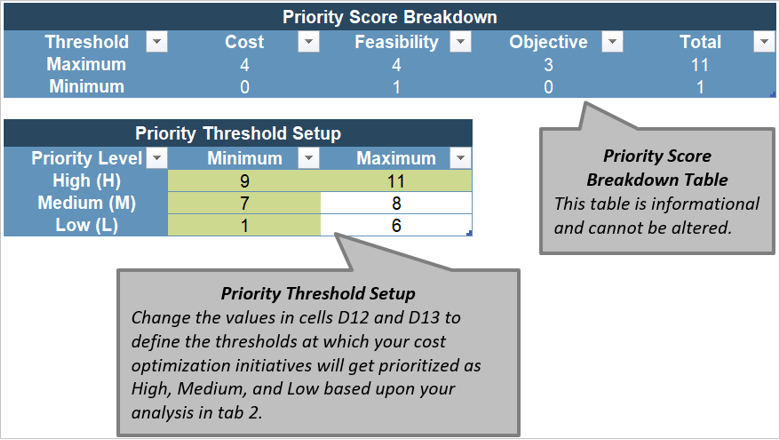
Template & Example
Estimate your timeline
Excel Workbook: IT Cost Optimization - Outline Initiatives Worksheet
Refer to the example and guidelines below on how to complete timeline estimates for each workforce optimization initiative:

| Column ID | Input Type | Guidelines |
|---|---|---|
| AA, AC | Dropdown | Select the quarter(s) in which you plan to begin and complete your initiative. |
| AB, AD | Dropdown | Select the year(s) in which you plan to begin and complete your initiative. |
| AE | Dropdown | Select the number of remaining quarters, in the current fiscal year, after you complete the initiative (0 to 4); based on columns AA to AD. |
| AF | Formula | Automatic calculation, no entry required. Estimate of cost savings in the current fiscal year, based on the remaining quarters after implementation. The entry in column AE is divided by 4, and the result is multiplied by the related estimated cost savings per year (entry in column L). |
| AG | Dropdown | Select if cost savings after the implementation of the underlying initiative will be Permanent or Temporary. |
Complete the following fields for each initiative in the Excel Workbook as per guidelines:
- Navigate to the Outline Initiatives tab.
- Determine the appropriate quarter and year to start and complete the initiative.
- Identify the time remaining in your current budget cycle after the completion of the initiative.
Template & Example
Make your final decisions
Excel Workbook: IT Cost Optimization - Outline Initiatives Worksheet
Refer to the example and guidelines below on how to assign the final priority for each workforce optimization initiative, and include it in your 12-month roadmap:
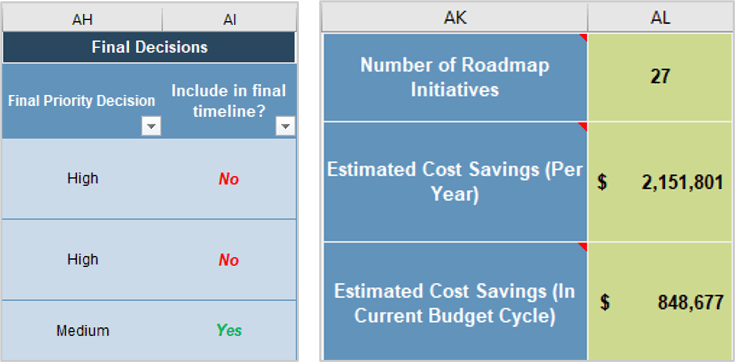
| Column ID | Row ID | Input Type | Guidelines |
|---|---|---|---|
| AH | - | Dropdown | Select your final priority decision after reviewing the preliminary priority assessment (column Z) and timeline estimates (columns AA to AG). |
| AI | - | Dropdown | Select whether you want to include the initiative in your 12-month roadmap (Yes or No). |
| AK, AL | 5 | Formula | Automatic calculation, no entry required. The total number of initiatives you decided to include in your 12-month roadmap; based on column AI when Yes is selected. |
| AK, AL | 6 | Formula | Automatic calculation, no entry required. Total estimated cost savings per year after the initiative's completion; based on column L when included in the 12-month roadmap (column AI when Yes is selected) |
| AK, AL | 7 | Formula | Automatic calculation, no entry required. Total estimated cost savings in the current fiscal year; based on column AF when included in the 12-month roadmap (column AI when Yes is selected) |
- Estimated cost savings per year refer to cost savings fully realized by the end of the upcoming fiscal year, following the initiatives' implementation.
- Estimated cost savings in the current budget cycle, refer to cost savings partially realized in the current fiscal year, after the initiatives' implementation.
Complete the following fields for each initiative in the Excel Workbook as per guidelines:
- Navigate to the Outline Initiatives tab.
- Determine the final priority of the initiative.
- Decide whether you want to include the initiative in your 12-month roadmap.
3.3 Develop your cost optimization roadmap
1 hour
- Conduct a final evaluation of your timeline, priority decision, and initiatives you wish to include in your 12-month roadmap. Do they make sense, are they achievable, and do they all contribute individually and collectively to reaching your cost optimization goals?
- Review your 12-month roadmap outputs in the IT Cost Optimization Workbook (see next slides).
- Make adjustments to your 12-month roadmap by adding or removing initiatives as you deem necessary (step 3.2).
- Document your final roadmap - including initiatives and relative time frames for execution - in the IT Cost Optimization Roadmap templates provided (see slide 97). The 12-month roadmap outputs from the IT Cost Optimization Workbook (see next slide) can facilitate this task.
Download the IT Cost Optimization Workbook
| Input | Output |
|---|---|
|
|
| Materials | Participants |
|
|
Template & Example
Potential Cost Savings Per Year
Excel Workbook: IT Cost Optimization - Outline Initiatives Charts Worksheet
Refer to the example below on charts depicting different views of estimated cost savings per year across the four optimization levers (Assets, Vendors, Project Portfolio, and Workforce) that could help you in your assessment and decision making.
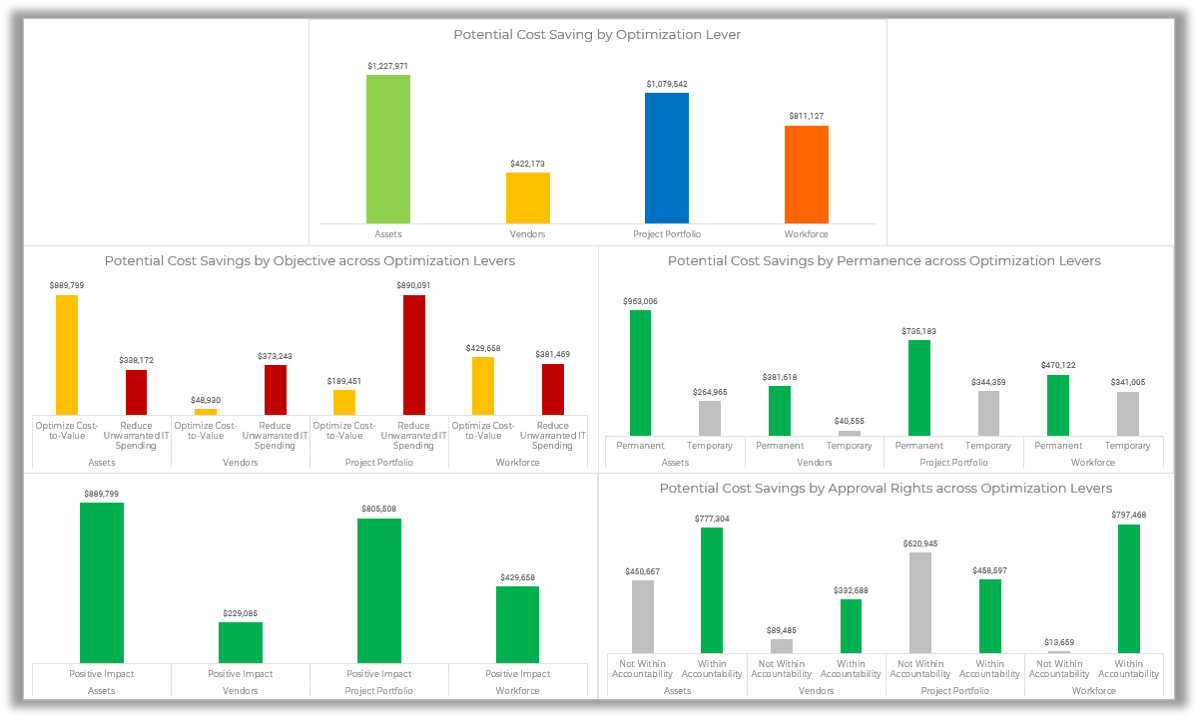
From the Excel Workbook, after completing your potential initiatives and filling all related entries in the Outline Initiatives tab:
- Navigate to the Outline Initiatives Charts tab.
- Review each of the charts.
- Navigate back to the Outline Initiatives tab to examine, drill down, and amend individual initiative entries or final decisions as you deem necessary.
Template & Example
12-month Roadmap Outputs
Excel Workbook: IT Cost Optimization - Diagram Results, List Results, and Timeline Result Worksheets
Refer to the example below depicting different roadmap output that could help you in presentations, assessment, and decision making.
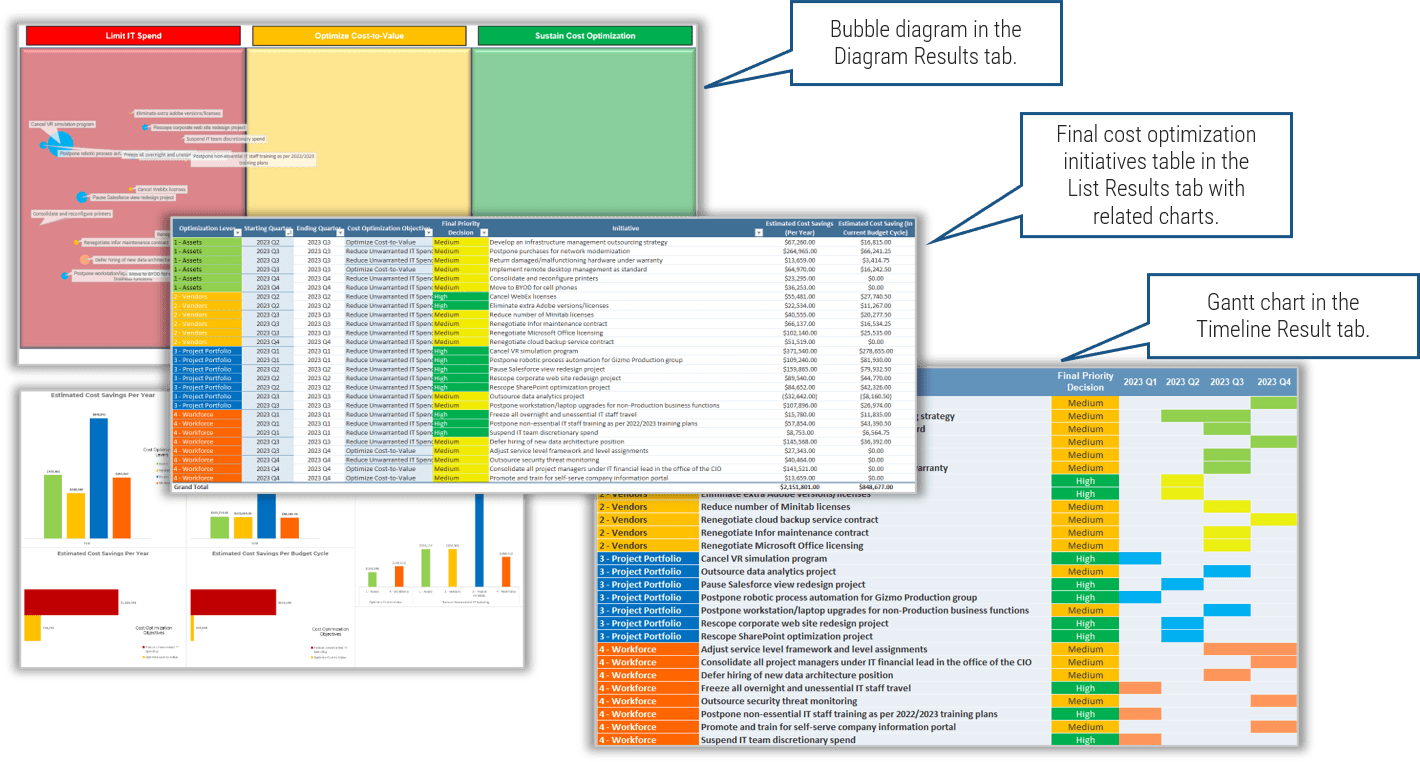
From the Excel Workbook:
- Navigate to the Diagram Results tab. This bubble diagram represent cost optimization initiatives by objective where each bubble size is determined by its estimated cost saving per year.
- Navigate to the List Results tab. You will find a list of the cost optimizations initiatives you've chosen to include in your roadmap and related charts.
- Navigate to the Timeline Result tab. This Gantt chart is a timeline view of the cost optimizations initiatives you've chosen to include in your roadmap.
Download the IT Cost Optimization Workbook
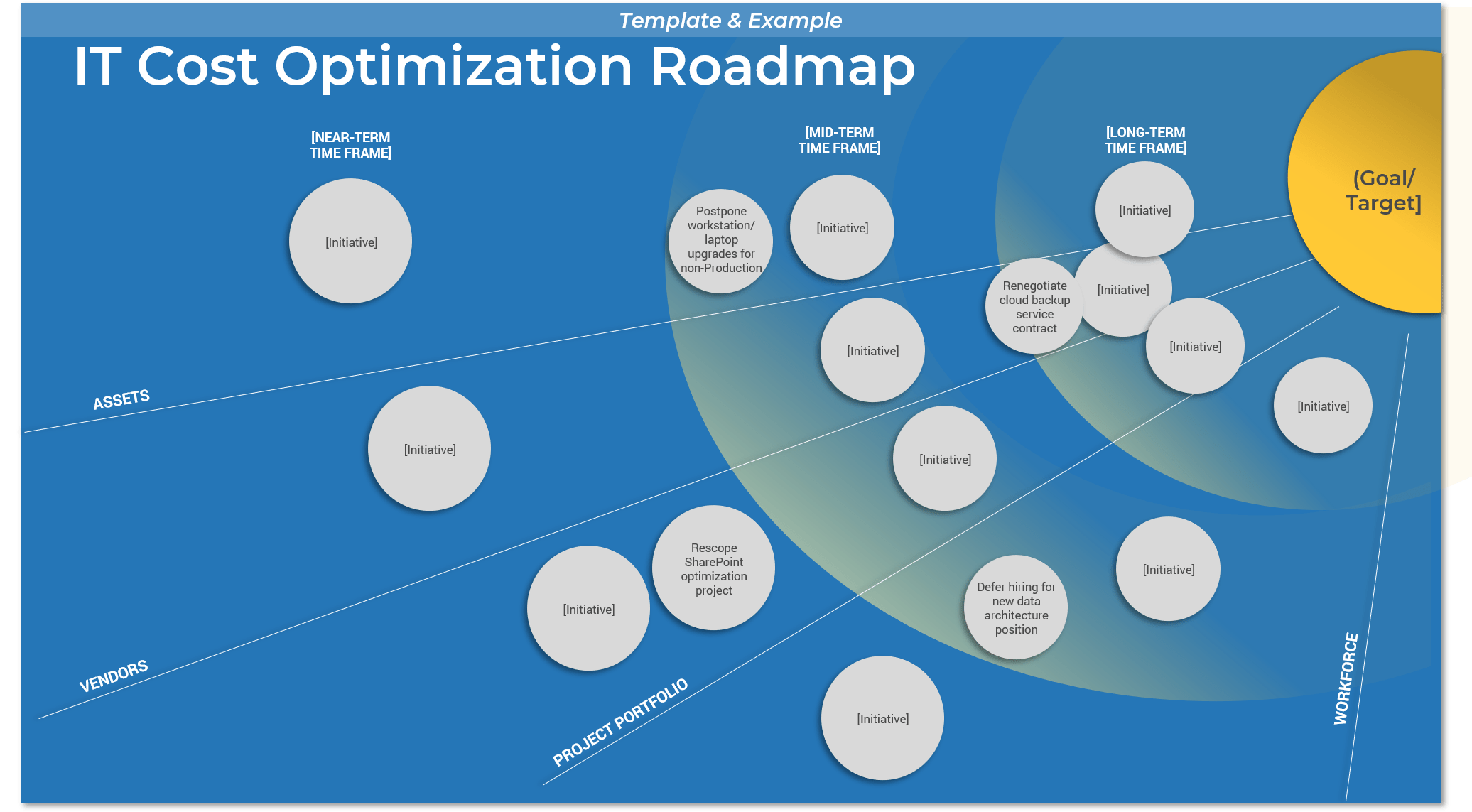
Phase 4
Communicate and Execute
Phase 1
Understand Your Mandate and Objectives
Phase 2
Outline Your Cost Optimization Initiatives
Phase 3
Develop Your IT Cost Optimization Roadmap
Phase 4
Communicate and Execute
This phase will walk you through the following activities:
- Cost optimization communication plan
- Cost optimization executive presentation
This phase involves the following participants:
- CIO/IT director
- IT finance lead
- PMO lead
- Other IT management
Build Your IT Cost Optimization Roadmap
4.1 Build the communication plan
45 to 60 minutes
- Use the Cost Optimization Communication Plan templates and guidance on the following slides.
- Complete the template to develop your communication plan for your cost optimization proposal and initiatives. At a minimum, it should include:
- Steps for preparing and presenting your proposal to decision-makers, sponsors, and other stakeholders, including named presenters and points of contact in IT.
- Checkpoints for communication throughout the execution of each initiative and the cost optimization roadmap overall, including target audiences, accountabilities, modes and methods of communication, type/scope of information to be communicated at each checkpoint, and any decision/approval steps.
Download the IT Cost Optimization Workbook
| Input | Output |
|---|---|
|
|
| Materials | Participants |
|
|
Understand a communication strategy's purpose
Put as much effort into developing your communication strategy as you would into planning and executing the cost optimization initiatives themselves. Don't skip this part.
Your communication strategy has two major components ...
- A tactical plan for how and when you'll communicate with stakeholders about your proposals, activities, and progress toward meeting cost optimization goals.
- An executive or board presentation that outlines your final proposed cost optimization initiatives, their respective business cases, and resources/support required with the goal of gaining approval to execute.
Your communication strategy will need to ...
- Provide answers to the "What's in it for me?" question from all impacted stakeholders.
- Roles, responsibilities, and accountabilities before, during, and after initiatives are completed.
- Descriptions and high-level information about dates, deliverables, and impacts of the specific changes being made.
You will also develop more detailed operational and project plans for each initiative. IT will use these plans to manage and track the execution of individual initiatives when the time comes.
Template & Example
Document the overall what and why of your planned communications
| Component | Purpose | Context | Key Messages | Intended Outcomes |
|---|---|---|---|---|
| Definition | Description of the topic and why you're communicating with this specific audience right now. | Background information about the broader situation and how you got to where you are today. | The main points you want your target audience to hear/read, absorb, and remember. | What you hope you and your audience will get at the end of the communication or effort. |
| Our Language |
|
|
|
|
Template & Example
Next, note the who, how, and when of your communication plan
| Stakeholder/Approver | Initiatives | Impact | Format | Time frame | Messenger |
|---|---|---|---|---|---|
| CEO |
|
Indefinitely delays current strategic projects | Monthly meeting discussion | Last Wednesday of every month starting Oct. 26, FY1 | CIO, IT data analytics project lead, IT VR project lead |
| IT Steering Committee |
|
Nearly all of these initiatives are enterprise-wide or affect multiple departments. Varying direct and indirect impacts will need to be independently communicated for each initiative if approved by the ITS. |
Formal presentation at quarterly ITS meetings Monthly progress updates via email bulletin |
Approval presentation: Oct. 31, FY1 Quarterly updates: Jan. 31, Apr. 28, and Jul. 28, FY2 |
CIO, IT service director, IT infrastructure director, IT data analytics project lead |
| VP of Sales |
|
Delays new sales tool efficiency improvement. | Meeting discussion | Nov. FY1 | CIO, IT Salesforce view redesign project lead |
| [Name/Title/Group] |
|
[Impact statement] | [Format] | [Date/Period] | [Name/Title] |
| [Name/Title/Group] |
|
[Impact statement] | [Format] | [Date/Period] | [Name/Title] |
| [Name/Title/Group] |
|
[Impact statement] | [Format] | [Date/Period] | [Name/Title] |
4.2 Build the executive presentation
45-60 minutes
- Download Info-Tech's IT Cost Optimization Roadmap Samples and Templates.
- Update the content with the outputs of your cost optimization roadmap and data/graph elements from the IT Cost Optimization Workbook. Refer to your organization's standards and norms for executive-level presentations and adapt accordingly.
Download IT Cost Optimization Roadmap Samples and Templates
| Input | Output |
|---|---|
|
|
| Materials | Participants |
|
|
Summary of Accomplishment
Congratulations! You now have an IT cost optimization strategy and a communication plan.
Throughout this blueprint, you have:
- Identified your IT mandate and cost optimization journey.
- Outlined your initiatives across the four levers (assets, vendors, project portfolio, and workforce).
- Put together a 12-month IT cost optimization roadmap.
- Developed a communication strategy and crafted an executive presentation - your initial step to communicate and discuss IT cost optimization initiatives with your key stakeholders.
What's next?
Communicate with your stakeholders, then follow your internal project policies and procedures to get the necessary approvals as required. Once obtained, you can start the execution and implementation of your IT cost optimization strategy.
If you would like additional support, have our analysts guide you through other phases as part of an Info-Tech workshop.
Contact your account representative for more information.
workshops@infotech.com
1-888-670-8889
Research Contributors and Experts

Jennifer Perrier
Principal Research Director, IT Financial Management
Info-Tech Research Group

Jack Hakimian
Senior Vice President, Research Development
Info-Tech Research Group

Graham Price
Senior Executive Counselor, Executive Services
Info-Tech Research Group

Travis Duncan
Research Director, Project & Portfolio Management
Info-Tech Research Group

Dave Kish
Practice Lead, IT Financial Management
Info-Tech Research Group

Baird Miller, PhD
Senior Executive Advisor, Executive Services
Info-Tech Research Group
Other Research Contributors and Experts
Monica Braun
Research Director, IT Financial Management
Info-Tech Research Group
Sandi Conrad
Principal Advisory Director, Infrastructure & Operations
Info-Tech Research Group
Phil Bode
Principal Advisory Director, Vendor Management
Info-Tech Research Group
Donna Glidden
Advisory Director, Vendor Management
Info-Tech Research Group
Barry Cousins
Distinguished Analyst & Research Fellow
Info-Tech Research Group
Andrew Sharp
Research Director, Infrastructure & Operations Practice
Info-Tech Research Group
Frank Sewell
Advisory Director, Vendor Management
Info-Tech Research Group
Related Info-Tech Research
Achieve IT Spend & Staffing Transparency
Most CIOs, CFOs, and business function leaders don't enjoy a shared vocabulary when it comes to talking about technology spend. As a result, truly meaningful conversations about where and how to spend technology funds in support of business goals are rare. Enable these important conversations by transparently mapping your IT spend data against four key stakeholder views.
Reduce Shadow IT With a Service Request Catalog
As the business gets more innovative to solve its problems, IT finds itself in reactive mode, dealing with software bloat, managing surprise SaaS renewals, and having to integrate products that they didn't know were purchased. To solve this, IT needs to focus on service and visibility to counter Shadow IT.
Bibliography
"A Short Guide to Structured Cost Reduction." National Audit Office, 18 June 2010. Web.
"IT Cost Savings: A Guide to Application Rationalization." LeanIX, 2021. Web.
Jouravlev, Roman. "Service Financial Management: ITIL 4 Practice Guide." Axelos, 30 April 2020. Web.
Leinwand, Paul, and Vinay Couto. "How to Cut Costs More Strategically." Harvard Business Review, March 2017. Web.
"Role & Influence of the Technology Decision-Maker 2022." Foundry, 2022. Web.
"State of the CIO 2022." CIO, 2022. Web.
"The Definitive Guide to IT Cost Optimization." LeanIX, n.d. Web.
"Understand the Principles of Cost Optimization." Google Cloud, n.d. Web.
Buying Options
Build Your IT Cost Optimization Roadmap
Client rating
Cost Savings
Days Saved
IT Risk Management · IT Leadership & Strategy implementation · Operational Management · Service Delivery · Organizational Management · Process Improvements · ITIL, CORM, Agile · Cost Control · Business Process Analysis · Technology Development · Project Implementation · International Coordination · In & Outsourcing · Customer Care · Multilingual: Dutch, English, French, German, Japanese · Entrepreneur
Tymans Group is a brand by Gert Taeymans BV
Gert Taeymans bv
Europe: Koning Albertstraat 136, 2070 Burcht, Belgium — VAT No: BE0685.974.694 — phone: +32 (0) 468.142.754
USA: 4023 KENNETT PIKE, SUITE 751, GREENVILLE, DE 19807 — Phone: 1-917-473-8669
Copyright 2017-2022 Gert Taeymans BV